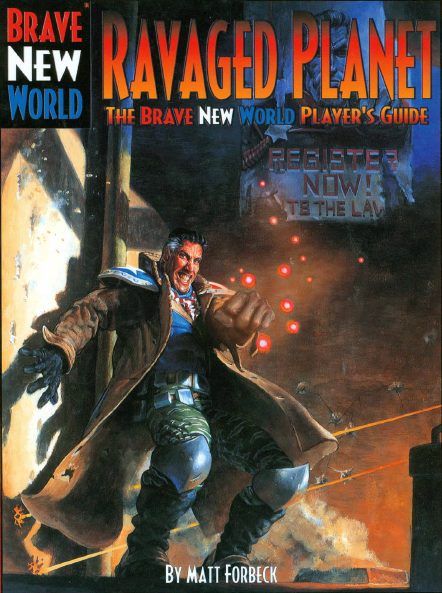Brave New World by Hostile V
Post
Original SA post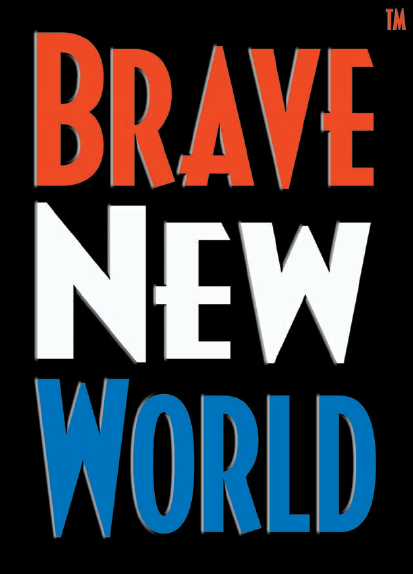
Brave New World is a tabletop RPG set in an alternate 1999 in a USA that has gone off the rails due to the existence of superheroes. Normally I don't really get into the origins of these games and the companies but there's some interesting context.
Brave New World was created by Matt Forbeck in 1999 for Pinnacle Entertainment Group shortly after the release of Deadlands 2.0. Pinnacle would later dissolve a relationship with AEG (Alderac Entertainment Group) and AEG got Brave New World in 2000. Now, there's a lot to be said about Deadlands and a lot has been said in the F&F archives. I like Deadlands. I like the premise a great deal, it's a creative exploration of an alternate timeline and cowboys with magic is rad as hell. But Deadlands has its share of issues, one of which being the problem of metaplot and consecutive books. So Deadlands 2.0 was out in 1999, but if one looks at the production history of Deadlands books it's right smack dab in the middle of half of Deadlands' pre-Savage Worlds release cycle (core game and Hell on Earth). Savage Worlds itself (and Weird Wars) would not be created until 2001 and its mechanics wouldn't really exist until then. My point is this: Brave New World came out in a weird point of Pinnacle's development history, in the middle of the success of Deadlands and the metaplot book strategy, two years before Savage Worlds, and BNW itself was sold to AEG by Forbeck when he left Pinnacle during the split. Hell, before the acquisition, there were at least two or three other books released for BNW in 1999/2000 along with the core book. This isn't mentioning the fact that the metaplot never got resolved or that the entire line was just plain cut short in 2001.
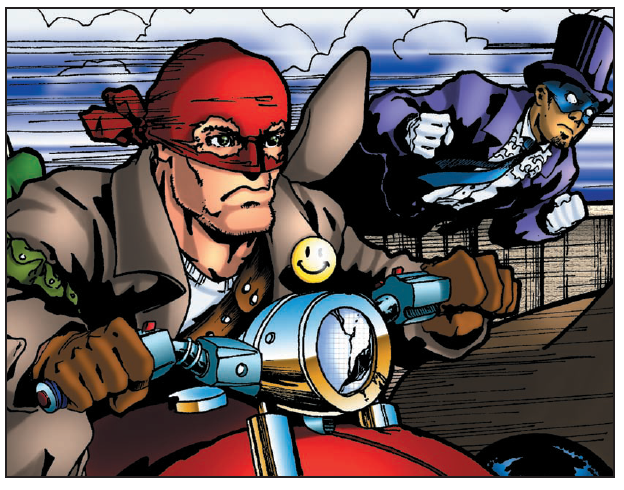
Here, have some art to break up the words. There's a lot of art. I'm not hurting for art to share.
Now, full disclosure: I was 9 to 11 during this time period. I couldn't go back in time to figure out what happened here, I'm having trouble digging up info on the internet. If anyone else here knows anything about the split, feel free to chime in. Essentially, Brave New World was Forbeck's baby and he was President of Pinnacle until the split and then brought his baby over to AEG where it was just shut-down preemptively. Considering how he's been trying to get other BNW things off the ground for a few years now and is writing books in the world, this is absolutely his passion project that he got to do after helping with Deadlands. And it never really particularly got anywhere. Hensley, the other guy who wrote Deadlands and actually started Pinnacle, would later leave Pinnacle, start Great White Games, create Savage Worlds and would juggle GWG while working at Cryptic Studios as head writer for City of Villains, leave Cryptic to try and make a Deadlands MMO, return briefly and then later turn GWG into Pinnacle again.

"If you can read this your already dead."
My point is that BNW is 100% Forbeck's baby but was had at a weird time and would later get a new step-parent that didn't give a fuck about it in the long run and BNW is still one of his passion projects. Again, a lot of this is speculation and just inferring from what I can find, but I'm telling you all of this to try and get you in the mind-set of when, where and how this game was produced. BNW was a guy's passion project that was going to be their company's second big game line, followed the design process of the first big game line (down to using a stripped-down Deadlands game engine) and then the whole thing imploded from business decisions and was forgotten except for some die-hard fan sites and the creator's own interests. Forbeck has since gotten the rights to write three books (BNW: Revolution, Revelations and Resolution) and AEG still has the rights but hasn't done anything past turn the books into PDFs.
So why am I sharing this with you? Honestly it's one of those things I heard about on and off throughout the years. When I got a chance to look, I took it. But when I dug deeper into the history and sat down to read it, I found some of my own fears reflected. I don't mean in the sense of the setting; I mean in the sense of having this cohesive thing you created, this idea you had, get unceremoniously buried from a mixture of circumstances and losing control of your own pet project. I write and I world-build and while Brave New World really isn't the best product, there's some things that interest me and make me feel a little bad for the product. Is it 90s as all fuck? It certainly is. But it was also the follow-up to a smash hit that just didn't go anywhere and it's interesting to pick through what we got knowing where it ultimately would have gone.
A HISTORY OF BRAVE NEW WORLD
Disclaimer: the following is all in-character fiction on a website run by rogue superpeople operating under the nose of the American government. It's very..."as you may know" by fiction standards and it's like "uh I paid attention in history/could have reasonably lived this, why are you reminding me of how much stuff sucks". Anyway, it's meant for the audience at home so I'm just gonna share it in my words.
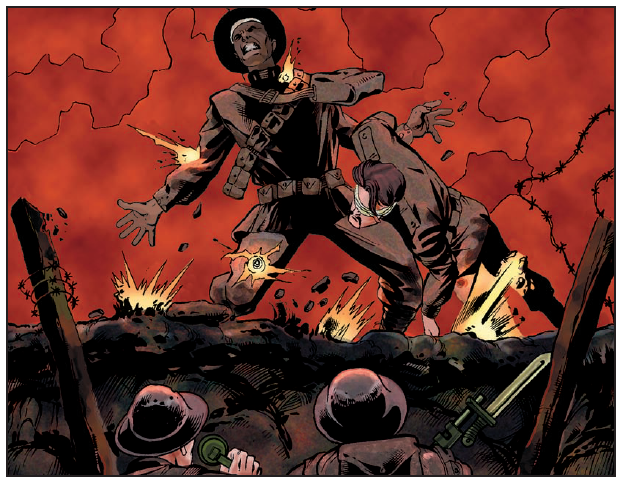
Peter Payne, seen here getting shot a bunch but not how canon says he got shot.
In World War 1, black soldier Peter Payne was shot in the chest by a German sniper trying to rescue another soldier trapped in No Man's Land. The bullet should have killed him, it was an inch from his heart, but instead Payne hit the ground and found after a moment's rest he could get back up, completely unharmed. The bullet that was in him was on the ground and he could phase through solid objects. Payne did his best to hide his newfound abilities but after a few months he was sniffed out and brought before American scientists. The scientists were stumped; he could phase through solid matter at will and they had no idea why. So instead the US government left Payne in Europe as an undercover spy, a top-secret operative who helped end the war months ahead of time. After the War, he stuck with the government as a spy (until much later) and in the 1930s he put on a mask and costume as the Silver Ghost. In the end, he would later leave the government's service and the USA to protect his granddaughter, taking her with him.
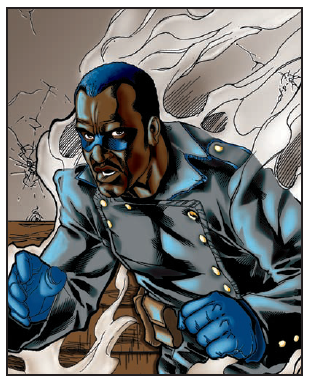
Silver Ghost has a really nice costume.
So Silver Ghost was the first Delta (and the first to work for a government) that people know of but he wasn't the last. People came back from the Great War with unexplainable abilities all over the world. The 20s and 30s were a time of experimentation for deltas (the name used because delta means change in physics, homo delta) and there were more people with powers than anybody expected. The start of supervillainy really took off but were generally kept in check by heroic deltas and the government. The most successful and famous hero of the time was the Yankee, a no-killing do-gooder from Chicago who actually built cases with evidence against the people he took down. When city hall deputized him, he helped Ness take down Capone and cemented himself as a superstar in the delta community. The Yankee was a sincerely good man and he inspired a slew of imitators and fans and turned Chicago into the nexus of American delta activity.

The Yankee vs. Mobsters.
Then World War II happened. When Pearl Harbor was attacked by both Japanese fighter pilots and their deltas, America responded by joining the war with their own. Delta Squadron was an elite Army unit lead by the Yankee that helped deal with the literal superpowers of every nation. Every side was more than willing to use what they had and ultimately the war ended because of deltas. Yankee and his sidekick Sparky were captured in 1943 by Kapitan Krieg (powerful Nazi delta, madman) and put in a concentration camp for deltas who refused to serve the Reich. The Yankee tried to revolt with the help of the other prisoners, but Krieg and the Nazi guards beat them down and threw them (alive or dead) into the ovens. And Sparky, still alive and burning to death in a Nazi concentration camp, tapped into an unknown tier of power to become the first Alpha. It took Sparky roughly five minutes to burst from the oven, gruesomely kill every Nazi guard, tear Kapitan Krieg to pieces, impale his head on the camp's gate and then fly to Berlin to personally murder Hitler from inside the command bunker. With Hitler's corpse, Sparky forced the war to end.
It's that kind of game and world, folks.
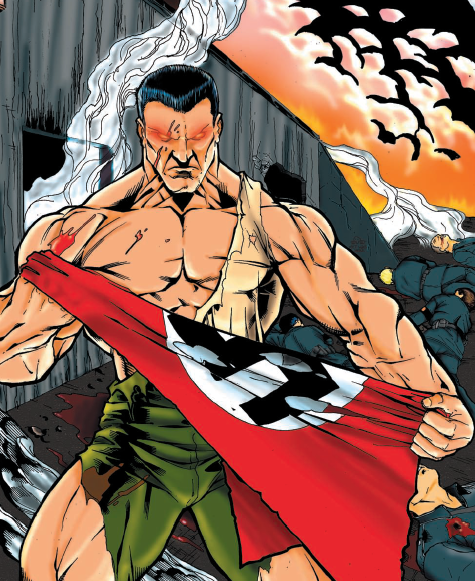
The birth of Superior, the death of a lot of Nazis and Hitler.
Sparky took the name Superior and became America's greatest protector...and weapon. The Russians responded by revealing dozens of alphas under their control. Alone, no being in the world could come close to stopping Superior. Together, they might have had a chance. Until 1949, the race to have and control alphas determined which nations had the most power and America was always in the lead thanks to Superior. But in 1949, the USSR revealed that they had invented the first hydrogen bomb (the Manhattan Project was just a pipe dream that got shut down). Soon it became a race to have both nukes and alphas. We finally got nukes in 1954 after some shenanigans with Senator McCarthy trying to do his witch hunt among deltas (until the HUAC was shamed by the original Patriot who testified).
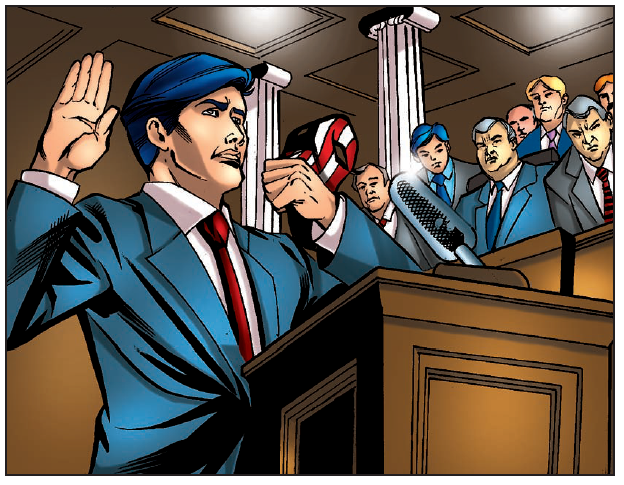
The original Patriot vs. Joe McCarthy.
Things were pretty good between 1954 to 1963 until the supervillain known as the Devastator tried to kill John F. Kennedy. His Dreadnauts (people in power armor) attacked the President's motorcade in Dallas and despite Superior's intervention and defeat of the Dreadnauts, Jackie and the governor of Texas John Connally were both killed. Superior carried the president to the country's top delta healers and JFK was in a coma for three days. When he woke up, he drafted and signed the Delta Registration Act.
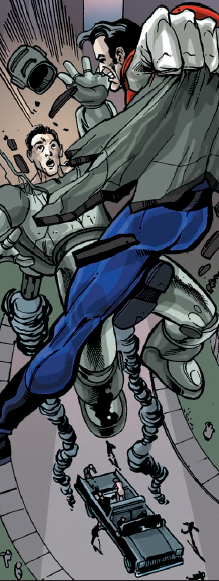
Superior tearing apart Lee Harvey Oswald's Dreadnaut power armor during the Dallas assassination. Yes, he was still involved.
The DRA is simple: if you become a delta, you must register yourself with the government so they can track your movements. It was passed into law in a week and Superior was the first to register. It was a massive violation of the Bill of Rights; any known deltas were badgered by the government into registering under threat of imprisonment. To police the law, Superior created Delta Prime from old Delta Squadron allies and registered deltas. Their job is twofold: arrest unregistered deltas and assist any Federal law enforcement agency in any matters that have suspected delta activity. When you consider that most deltas are running around in masks on either side of the law (and because people in masks can't testify in court, some deltas just killed criminals), you've got a problem.
There were two outcomes from this decision. First, the organization Defiance was formed by a group of deltas who went underground to protect themselves and their loved ones. They focus on both fighting the government and just plain keeping themselves safe in loosely connected cells and group. Defiance runs a website (deltatimes.com) that the government can't crack (because it's 1999 internet) and JFK doesn't want to risk shutting down the internet because it's good for business (this is before the Dotcom Bubble Collapse and the rise of the search engine). Defiance uses the website and word of mouth to coordinate missions and info (or at least what the public can see). Second, criminals and supervillains and good people fought back against the police and Delta Prime with force. The Devastator himself was nearly captured in an underground lair beneath New York City and only escaped when he used a self-destruct device that collapsed every aboveground building on top of his lair for four blocks (skyscrapers included).
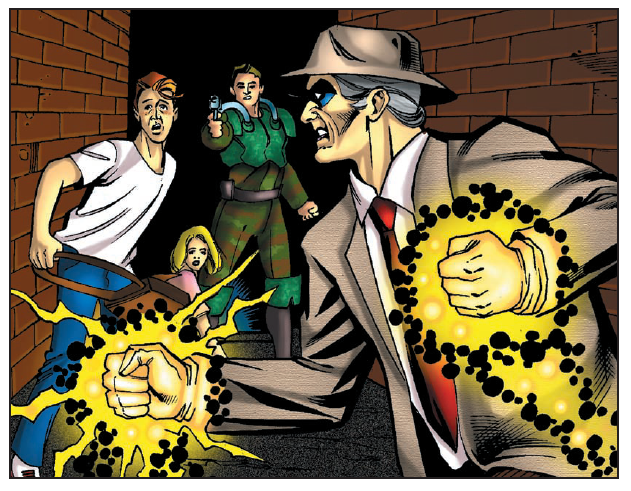
Even in the book this picture has no context and I have no idea what the heck.
Kennedy ends up using the destruction of Manhattan to declare martial law across the USA and assume total control of the country. Good news: the DRA is no longer unconstitutional because bad news America is now under the control of one man. The 60s and 70s are a blur of power creep on behalf of the government as Kennedy replaces the suspended governmental institutions and Constitution with people willing to do what he says. America basically lets him, terrified of another Manhattan and wanting revenge. Delta Prime fills its jails, builds a new super jail called The Fortress somewhere in Nebraska and builds New Alcatraz when The Fortress gets too full. They also kill any delta who "resists arrest".
Everything gets way, way worse on July 4th 1976 when the Devastator threatens the entire city of Chicago with a doomsday device on top of the Sears Tower. His demand was that Superior personally surrender to him. And when Superior and Delta Prime confront him over it in what's later called The Bicentennial Battle, he detonates it. The device ends up doing two things (man, bad things come in twos in this game). First, the entire city of Chicago is disintegrated; everything in a 25 mile radius of the tower, everything in the airspace and half a mile of underground are just gone. Lake Michigan flows into the crater and causes floods, tornados, havoc. The other effect was that every alpha around the world that wasn't imprisoned was suddenly gone. Superior was taken with the blast, but alphas in the USSR, China, anywhere were just gone. On top of that, since 1976 there's way less of a chance for deltas to become alphas.
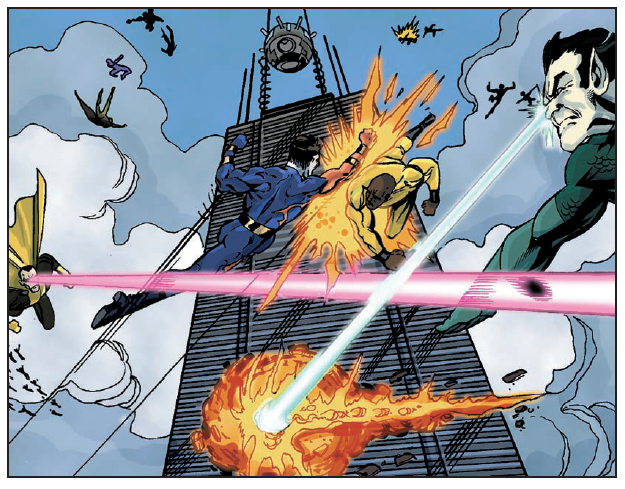
The Bicentennial Battle in motion.
If you think things are going to get better/easier because all of the alphas are gone, try again. Superior promised to kill the leader of any country who used a nuclear weapon. He made the Korean War and Vietnam War end quickly in favor of America and no country wanted to fuck with us, but then suddenly he's gone. And with Superior gone, the nuclear clock got a kick in the ass. Deltas are fighting national wars across the planet and one skirmish almost started World War III when Delta Prime fought a bunch of Russian deltas at Chernobyl in 1989 and the nuclear plant when up in a cloud. The Russians nuked Atlanta, America nuked Kiev and Minsk and Russia responded by nuking San Francisco.
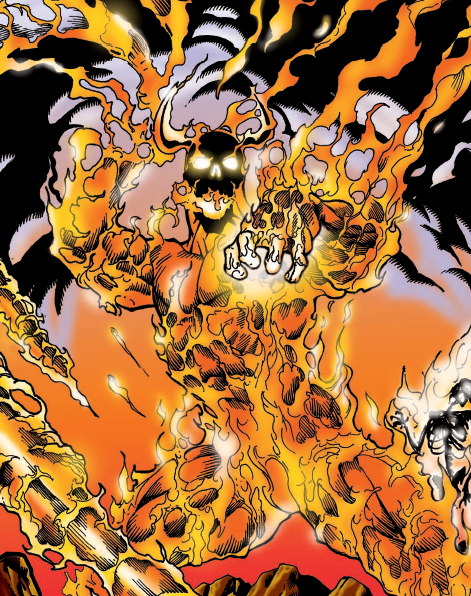
The Devastator. To be honest, considering what's said in the book I completely expected a Doctor Doom knock-off like Doctor Destroyer so it was really weird for "a master of engineering and occult" to be a fucking fire elemental. Nice outfit, but odd design considering everything said about him.
So the year is 1999. America is a fascist dictatorship run by JFK who is pushing 83 and still kicking (he's doing fantastic, actually). The flooded crater of Chicago has been rebuilt as Crescent City: highest population of deltas around, general focal area for plot/activity and home of New Alcatraz over the water. Atlanta and San Francisco are still radioactive ruins. The USSR is still going strong, the planet is pock-marked with nuclear scars and deltas are fighting for countries or trying to find safety. If you want to find out more about the world I guess you better go pick up that expansion book that will tell you more (it's out now already!).
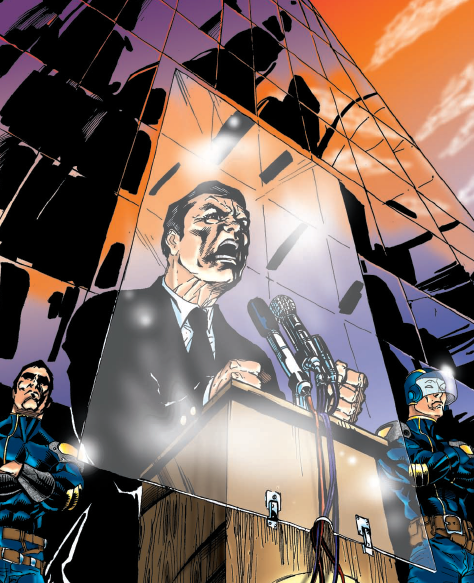
JFK giving a speech in Crescent City.
The game actually gives you a choice about whether or not you register, which is interesting because it's overwhelmingly in favor of playing as members of Defiance.
You have a week from your first manifestation of powers to register. Register your powers and you don't necessarily have to hide your powers. You can use them and not be arrested simply for using them, you can cooperate with the police if you're suspected of something that happens using powers that match yours and have a better chance of walking away free. With registered powers, you can join Delta Prime (or Delta Academy if you're under 18), go into work in the private sector with your powers (Triumph, Inc. is the biggest American employer of deltas), open your own business or go freelance with your heroics and get paid by insurance companies. Of course if you register, your personal info is public, you have to tell the government where you are or where you're going, because your info is public your enemies can target your loved ones/neighbors/friends, you have zero rights and the government can draft you at any time for any reason or period of time.
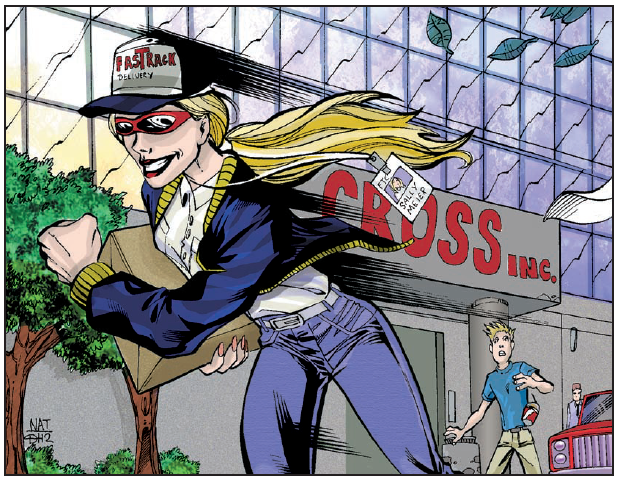
Gotta get paid somehow.
Not registering means you have to live a double life or secret life. You can't trust other people, staying mobile is your best bet for safety and if you're caught you're either going to prison for life or getting killed. If you're arrested, you'll get grilled unmercifully for any allegiance or info you can give the feds about Defiance even if you're not in Defiance. If you're going to do anything heroic/villainous, you need a mask or you can join Defiance. Their ultimate goal is to get rid of Kennedy, get rid of the DRA and undo the martial law and they're willing to do it peacefully or through revolution. There's no living a regular life unless you want to try fleeing America, and the rest of the world is still in an augmented state of Cold War. The world is unsafe and it's only getting worse.
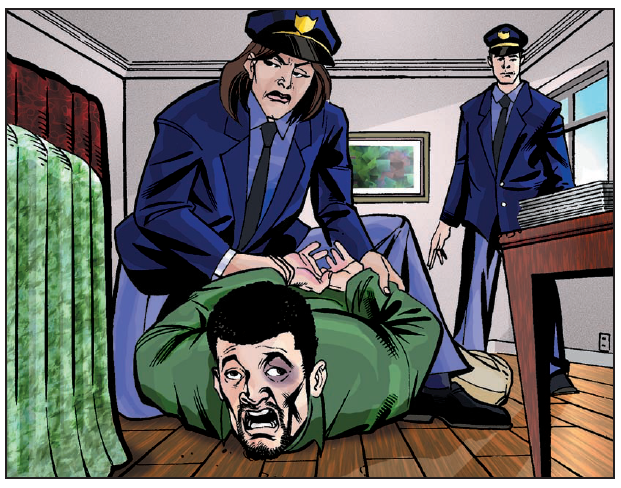
So that was all the prologue. All of it. There's 35 pages of world building and back story and from there we get into Chapter One. There's also a mini comic at the beginning of the book that shows the capture of the latest Patriot by Delta Prime when he tries to save a college girl delta and all the art is in color. There's quite a bit of color art, it's rather nice compared to the black and white work, but I couldn't reasonably share all of it.
Let me sum up Chapter One in a few sentences because it's 16 pages long. This is a role-playing game, it uses d6 dice. Role-playing games are games about playing a role, you should try it, it's fun. It's probably a good idea to use maps or miniatures too. There, that's Chapter One. The game has 13 chapters and the entire thing, cover to back, is 226 pages long. Strap in, it's going to be uneven and the mechanics are going to go off the rails.
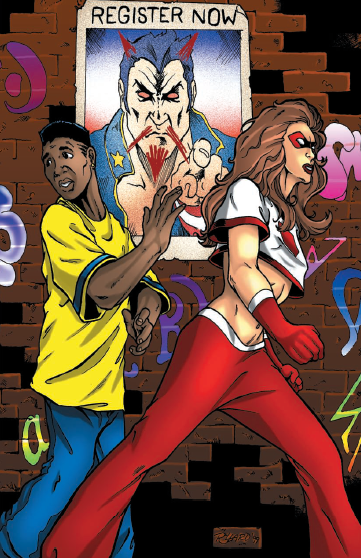
I think that's supposed to be Superior on the poster but doodling aside it's hard to tell.
NEXT TIME: Chapter Two, What It Takes To Be A Hero (aka character creation). I would normally love to build a character as an example but I think this time I'll pass because the mechanics come after building a character. There are also sample characters but I'll share them much later too because you need the mechanics to appreciate just what the hell they stand for. Also this is the 90s so there are a shitload of skills. I'm kinda dragging on, aren't I? I'm just getting very sure that my sympathetic feelings towards this product will go away the longer it takes me to do this book and balance Rocket Age. Anyway, see you guys next time.
Post
Original SA post
CHAPTER TWO: What It Takes To Be A Hero
Heroes are defined by their traits, skills, quirks and powers. Your Traits are your attribute stats: Smarts, Speed, Spirit and Strength. You have to have a minimum of 1 in each and a max of 5 during character creation and you've got 12 points to spread out. Your average human has a 2 in a Trait.
Smarts represents education and brain things you can do. Speed is the Dexterity stat, influencing dodging and shooting. Because this is a 90s RPG, this is an important stat. Spirit is your mental fortitude/charisma stat. Strength is strength and also health so don't skimp too much on this one. There are also the traits of Pace and Size. Size is...size and everyone is by default Size 5, just like nWoD. Pace is how fast/far you can move in a round and is Total Speed Dice+Speed Bonuses+5. In a single round, you can move that far in inches (for tabletop minis) or multiple your number by 2 for yards. Yes, this means Skippy Nopowers can move 14 yards every round.
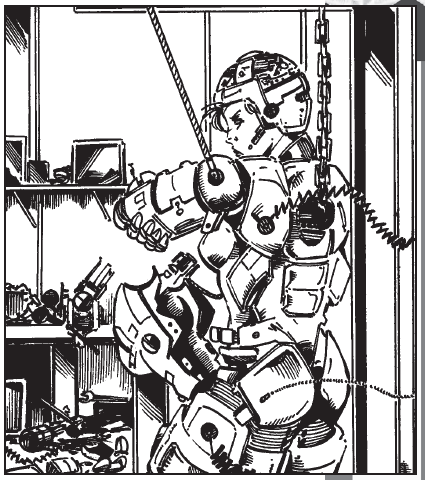
I put on my robo-pants like everyone else, one rivet at a time.
Skills are...skills and because this is a 90s RPG it takes 26 pages with this formatting to go over every skill. When you want to use a Skill, you roll the correlating Trait then add the stat you have in that skill to the final result. If you pick a skill that has subskills (like Driving) you can't just take the parent skill, you have to pick a subskill (like Personal Vehicle). Worth noting: Shooting does not have subskills but Fighting and Martial Arts do. Just keep this in mind. What's nice about Skills is that they aren't just tied to Smarts, you get 3xParent Trait points to pick skills and you get some skills for free. You can have 5 points max in a skill at character generation.
Quirks are...*sighs* they're Advantages/Disadvantages.
Powers are powers. They're always on, which is an interesting way to go about it, because your powers are basically just always flat bonuses or conditional modifiers unless they're something like "Energy Beams".
There is actually one more thing to mention: Tricks. Tricks are basically feats and you can pick them from a general list or a list of tricks that relate to your type of Delta.
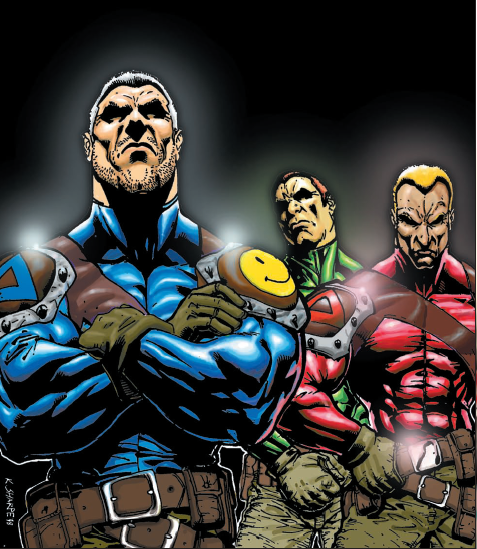
The friendly faces of Delta Prime agents.
HOW TO MAKE A CHARACTER
Choose between an archetype or building one from scratch. There's premade characters in the book; those are the Archetypes. Making one from scratch is point-buy building.
1: Spread 12 points across Traits. 2: Spend skill points, your pool being 3xTrait Number. 3: Spend leftover skill points on Positive Quirks or take up to 10 points in Negative Quirks to get points. Actually this is kind of a bad idea to tie your points for Quirks to your friggin' Skill Points. Quirks aren't tie to Traits, so you just take any leftover points per Trait set and add them up. 4: Pick a power package. You only get one choice, it can't be changed and there are (currently) no rules for becoming an Alpha so weigh your choices. 5: Pick three Tricks. 6: Buy your gear. You have $1000 to spend, more or less depending if you took wealth-related Quirks.
So let's take a look at the different types of Delta that are available. There are 10 to choose from, you can't make your own and if you want more Delta types then you better buy the other books.
- Bargainer: Summon, bind and control demons for power.
- Blaster: Shoot energy blasts.
- Bouncer: Enhanced movement speed and strength.
- Flyer: Uh. Fly.
- Gadgeteer: Build physics-bending items. Like power armor. Do you like power armor? I hope you like power armor. This class isn't as broken as you might think it is.
- Goliath: Get permanently huge and strong.
- Gunner: Be really, really good at shooting people. Reminder: there are no subskills for Shooting.
- Healer: Heal people.
- Scrapper: Augmented strength and natural enhanced regeneration.
- Speedster: Go Fast.
You may notice that one of those doesn't really seem to belong on this list. We'll talk more in depth about this later.
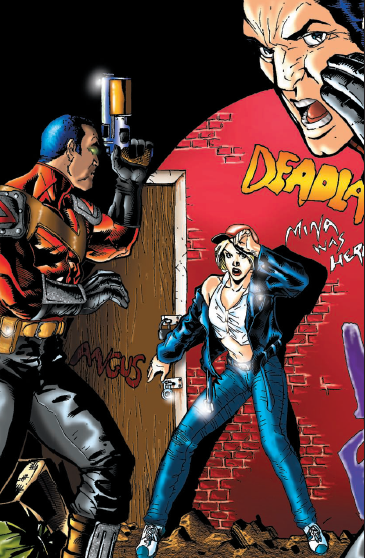
I think this is supposed to be Delta Primers cornering a delta. There's no context given.
CHAPTER THREE: The Basic Mechanic.
Everything in Brave New World revolves around Target Numbers and hitting that number to do something. The number in your Traits refers to a dice pool of d6s and how many you have to roll. When you roll them, you can take the highest of all results and use it as your result to augment with modifiers. Plus, sixes explode and if it's another six it explodes but they don't add.
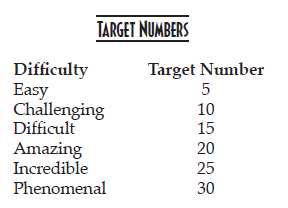
Example: Billy Everyhero gets two sixes in his dice results. He rerolls the first and gets a 1. He rerolls the second and gets a 5. The final numbers are a 7 and a 11 and Billy's clearly going to pick the 11.
For every 5 points over the TN, you get an Extra Success which you can cash in for other mechanical benefits with related Tricks. If you don't know the Trick, it costs 3 extra successes.
Opposed Rolls are simply "highest result wins" after everyone rolls and the rule of Extra Successes applies.
If you get a majority of 1s in a dice pool, you get a Shadowrun-style Disaster where no matter if there's a success in the pool, it all fails.
If your lowest possible action roll is equal to a TN, you can do it without rolling or roll anyway, up to you.
I'm not going to lie, I'm surprised at how quick this book goes by. It's somewhat refreshing.
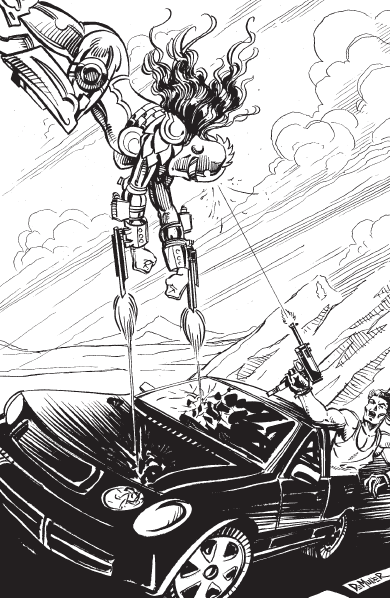
Eat shit, bad drivers!
NEXT TIME: Skills'n'Quirks. I have to do both at once because I can't stomach splitting them up and wasting extra time.
Post
Original SA post
CHAPTER FOUR: Getting the Job Done
So you get Skills to pick equal to 3xStat in the skills that apply to that stat. You can transfer points between stats with a conversion of two-to-one, so 4 Strength Skill points become 2 Smarts Skill points.
The following Skills are free at creation: Area Knowledge (Hometown) 2, Climbing 1, Language (Native) 2, Scrutinize 1 and Search 1. These skills are recommended in general: Bravery, Driving (Personal Vehicle), Fighting (Barehanded), Perception, Persuasion (Bluff), Stealth and Swimming.
The majority of these are straight-forward and I really don't feel like explaining what they all are. Some of them I will if they don't immediately make sense and I'll include any interesting charts or art I find.
Smarts
- Academia (American culture, comparative literature, history, occult)
- Artillery
- Area Knowledge (City, county, state, region, country)
- Bureaucratics
- Computing
- Criminology
- Demolition
- Disguise
- Etiquette
- Forgery
- Gambling
- Language (any)
- Medicine
- Navigation
- Profession (Accounting, administration, architecture, business, clergy, finance, law, engineering)
- Science (Biology, chemistry, geology, mathematics, physics)
- Security
- Survival (City, desert, forest, mountain)
- Tactics
- Tinkering
- Weaponsmith
- Acrobatics
- Archery
- Boating (Speedboat, sailboat)
- Dodging
- Driving (Personal vehicle, commercial vehicle)
- Escaping
- Flying
- Lockpick (Electronic, mechanical)
- Martial Arts (Barehanded, club, blade)
- Piloting (Airplane, helicopter)
- Quick Draw
- Riding
- Sleight of Hand
- Shooting
- Speed-Load
- Stealth
- Trade (Carpenter, electrician, machine operator, mechanic, plumber)
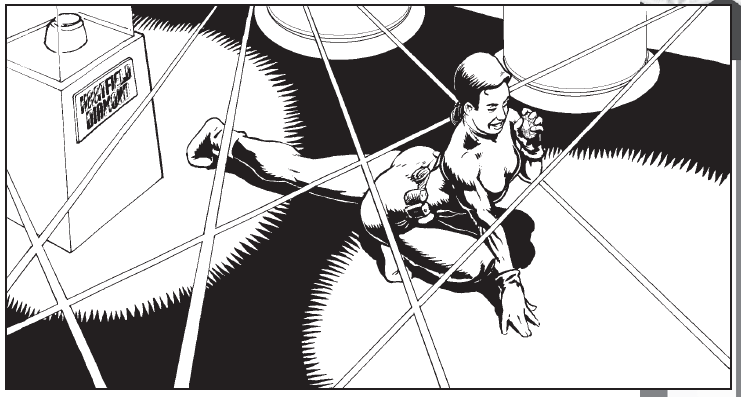
Her poor spine and joints.
Spirit
- Arts (Illustrating, music composition, painting, sculpting, writing)
- Bravery
- Faith
- Leadership
- Mimic
- Perception
- Performing (Acting, public speaking, music, singing, storytelling)
- Persuasion (Bluff, charm, interrogation, intimidation, seduction, taunt)
- Scrounging
- Scrutinize
- Search
- Shadowing
- Streetwise
- Tracking
- Climbing
- Fighting (Barehanded, club, blade)
- Running
- Sport (Baseball, basketball, deltaball, football, hockey, soccer)
- Swimming
- Throwing
Academia: I don't have to explain this one, it's just non-science smarts, but I find it hilarious that you can just take Comparative Literature. I wouldn't put it past certain Deltas to end up focusing on Randian Objectivism.
Bravery: You can roll this before you do something incredibly stupid or more likely when the GM makes you do it to do something. If you fail you panic and freeze.
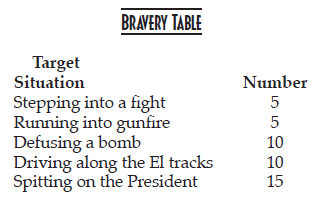
Bureaucratics: 90s as fuuuuuuuck.
Dodging: Put points in this for combat.
Driving: Pretty much just for stunty driving, if you have to drive normally you can.
Escaping: Not just for death traps, also for being tied up. It's also explicitly mentioned that most villains just straight-up kill heroic deltas by shooting them in the head.
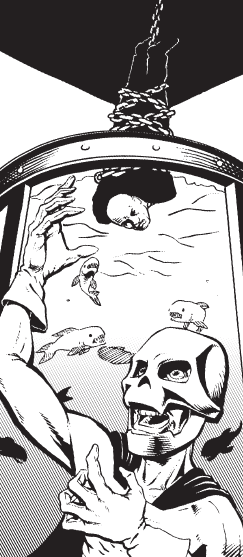
Distant cackling.
Faith: How strongly you believe in your faith. Some kind of deltas might need this for their powers! Who knows! Stay tuned for more books!
Forgery: Surprisingly necessary because important papers are needed for a lot of things.
Gambling: Does not work in actual gambling or games of chance like roulette or craps. This is for, like, poker and cheating in poker.
Language: 1 is illiterate in that language and child talk, 2 is high school level and writing.
Leadership: Prevents surprise and the person with the Leadership skill can give other people their extra actions per round.
Mimic: Copy someone's voice and mannerisms. Separate from disguise.
Profession: Not actually used to make money.
Quick Draw: It's TN 5 to draw and shoot in a firefight. You probably don't ever need this skill to be over 3.
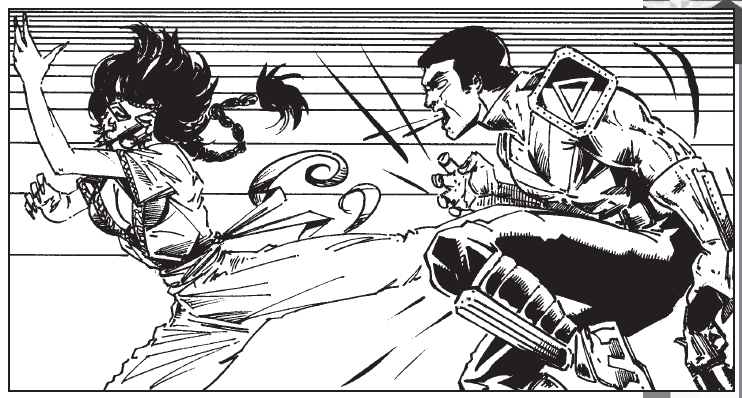
Scrutinize: Sense Motive, also spot fakes.
Search: Find people, not things.
Speed-Load: Reload faster, more useful than Quick Draw.
Sport (Deltaball): An organized sport for deltas only because they can't/should not play normal sports. It's like Blood Bowl, basically.
Tactics: A role-play only skill where good rolls help plug holes in the plan.
Tinkering: Mandatory for Gadgeteers.
CHAPTER FIVE: The Well-Rounded Hero
So yeah. Advantages and disadvantages. There are way more negative quirks than positive ones. You have to have one of the following quirks per choice.
Delta or Reg (0): If you're a Delta, congrats. You're a superhero. If you're a Reg, congrats. You're a normal person. You can kind of just stop here and not worry about the rest of the book if you're a normal person.
Public Identity or Secret Identity (0): If public then you better be registered, otherwise you immediately get the Wanted quirk.
Registered or Unregistered (0): Give the government every detail of your life or don't.
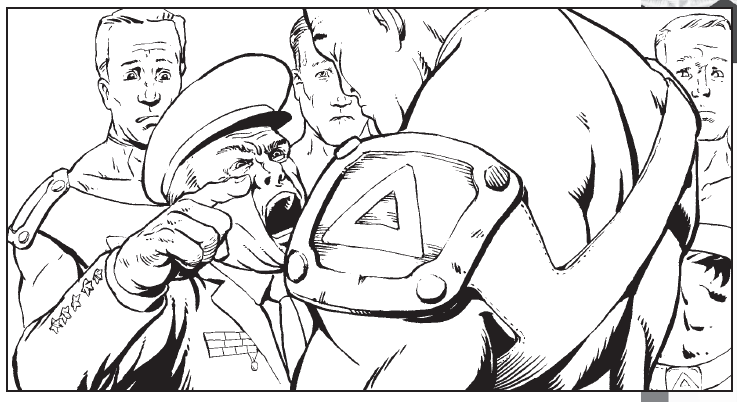
Yellin'.
POSITIVE QUIRKS
Alert (3): +2 to Perception/Search.
Ambidextrous (5): You're really good at dual-wielding or using either hand. Incredibly handy for combat.
Authority (1-5): The higher the level, the more power you have. You have to take Duty as well.
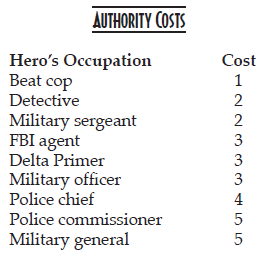
Beautiful (1): +2 to Persuasion for lookin' good.
Brave (1): +2 to Bravery rolls but you need a Spirit roll to run when you should.
Brawny (3): Requires Strength 4. Increases Size to 6.
Contact (1-5): Talk this over with your GM but this is the friend trait.
Dark Secret (1-5): This is both positive and negative. Negative is "you have a dark secret that could wreck you". Positive is "you have someone's dark secret and could wreck them".
Destined for Greatness (5): You can't die to minor bad guys or threats, only major villains. Handy.
Double-Jointed (1): +2 bonus to Escape.
Famous (2): +2 bonus to Persuasion rolls depending on what you're famous for.
Favor Owed (1): Once it's called in, it's gone.
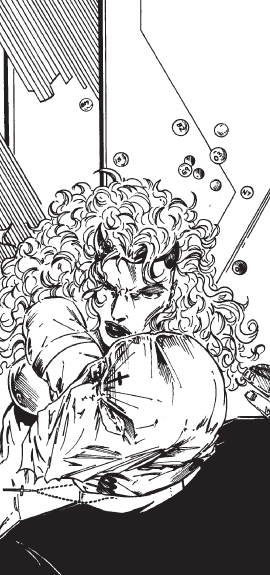
Gear (1-5): Each point is roughly 50K or more. Good for getting that expensive thing.
Iron Jaw (3): -2 to TN when hit with a Stun attack.
Light Sleeper (1): -2 to TN to wake up if suspicious things are happening.
Lucky (3): Get an extra Delta Point. This extra point can be used in the normal ways plus it can undo a disastrous roll. What's a Delta Point? Well, everyone gets 3 and they're basically explained later and the alter rolls. Also includes the incredibly unfortunate sentence "The world treats your hero like she's Irish and every day is St. Patrick's feast".
Ordained (1): You can do religious stuff legally. Sure, why not.
Patron (2-5): Someone can help when you need it.
Photographic Memory (5): Smarts rolls to recall stuff.
Rich (1-5): Get munny.
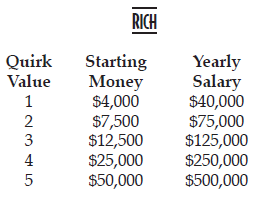
Self Confident (2): +2 to any Persuasion rolls when resisting someone's efforts.
Sense of Direction (1)
Sense of Time (1)
Sharp Ears (1): +2 to hearing Perception rolls.
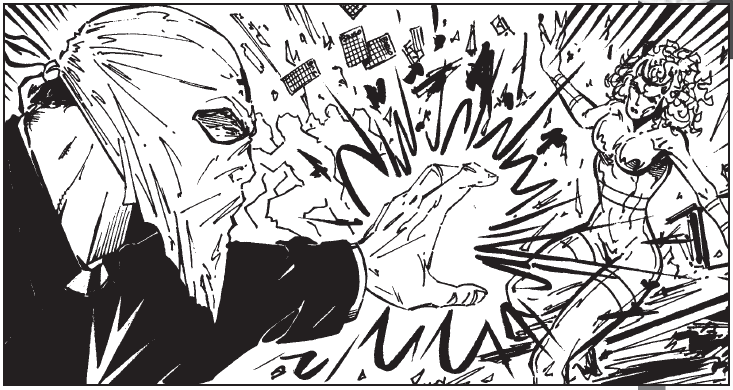
Sharp Eyes (1): +2 to sight Perception.
Sidekick (5): Build a teenage buddy to assist you then Vow to protect them.
Tough (2): -1 to Wound-Effect modifiers you're suffering from.
Veteran (0): Get 5 free points to spend on Skills, Quirks or Tricks but get a Rank 5 Enemy and Wanted for being a veteran hero.
Voice (1): +2 to friendly Persuasion, +2 to hostile Persuasion.
Wise (3): Spirit roll to ask the GM if you're about to make a mistake.
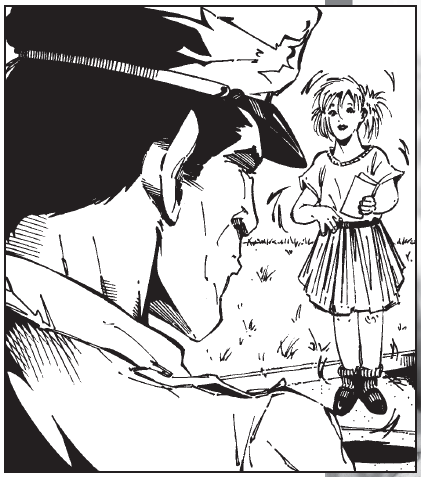
Context needed. Seriously. There's no context even in the book.
NEGATIVE QUIRKS
Absent-Minded (3): +3 to the TN of any Perception roll for things you're not focused on.
Addiction (1/3): Lesser is jonesing for minor things, major is severe. If dry for 24 hours, add +3 to any Smarts roll TN or +5 if severe.
Arrogant (3): You're a dick. +2 to TN for any non-hostile Persuasion rolls.
Bad Habit (1-3): You do something that grosses out other people if they see you do it. If they see you do it and you try to friendly-Persuade them, add your rank in Bad Habit to the Target Number.
Bigot (1-3): You're even more of a dick and this is meant more for NPCs.
Bloodthirsty (2): TN 10 Spirit roll to not murder someone surrendering to you in a fight.
Cautious (3): Spirit rolls to act beyond your careful nature.
Cheap (2): Find gear 25% cheaper because you're frugal but if it's damaged, roll a d6 and if the result ends up 10+, it breaks.
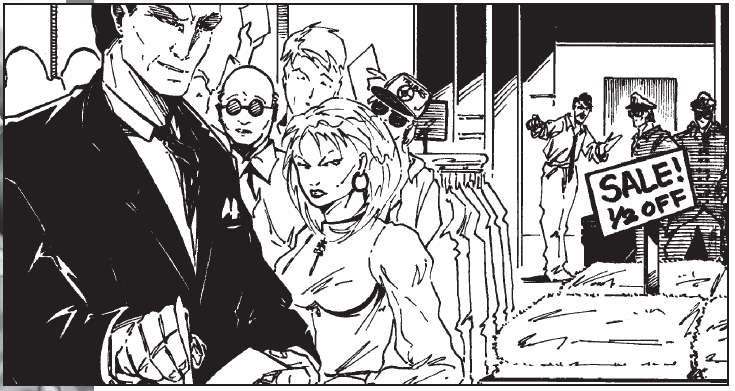
Deals so low, they're insane.
Clumsy (3): +2 to TN on unskilled Speed rolls. Doesn't apply to Skilled ones because you're trained to not be clumsy.
Code of Honor (3): Don't kill needlessly (especially in cold blood), don't hit someone from behind, don't ambush. +2 bonus to Persuasive rolls if you have to be a cape-type person and Persuade people.
Coward (3): You're cowardly and if people know you're a coward, +2 to the TN of Persuading them.
Crazy (1-5): The "Legitimate Mental Illness" trait.
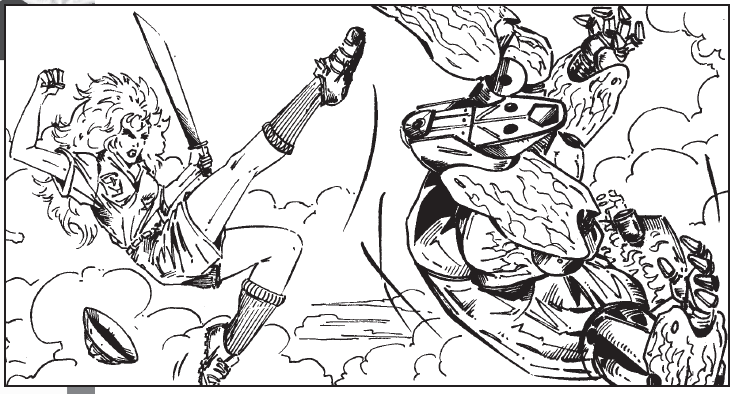
Curious (3)
Dark Secret (1-5)
Death Wish (5): You're fixin' to die and you're taking big stupid risks. That's it. No mechanical rules for it.
Dependent (1-5): This is the "I have annoying family/friends" Quirk that you take and have to pretend to feel sad when they inevitably die or you just mail them off to Sweden.
Disabled (3/5): Yep. Rules for having impaired legs/arms.
Duty (1-5): The more demanding it is, the more points you get back.

Enemy (1-5): Has to be a distinct person. No rules besides "the more powerful/they show up, the more points you get back".
Frail (3): +1 added to any Wound modifiers you're suffering under.
Glass Jaw (3): +2 to TN to making a stun check.
Greedy (2): No real mechanical use.
Gullible (2): Opponents get +2 bonuses to their attempts to persuade you.
Heavy Sleeper (1): +2 to TN to waking up from suspicious noises.
Hefty (2/3): Increase Size to 6 and reduce Pace by 2 or increase to 7 and reduce by 4.
Heroic (5): You're, uh. Heroic. Boo. Hiss.
Honest (3): Can't take Bluff, people get +2 bonuses to Scrutinizing your lies but you get +2 bonuses to Persuasion if folks know you're honest.
Illness (1/3/5): Your rank in the Quality is the TN you have to beat for Strength at the start of every session. Success is good, failing imposes modifiers, critically failing makes your illness worse.
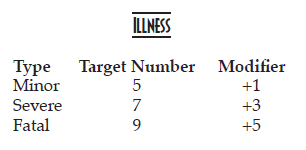
Illiterate (3): Y Kant Delta Read? You can only have a 1 in Language for any language.
Impulsive (3): Any time you need to make a plan, TN 10 Spirit roll to not stomp off in a huff.
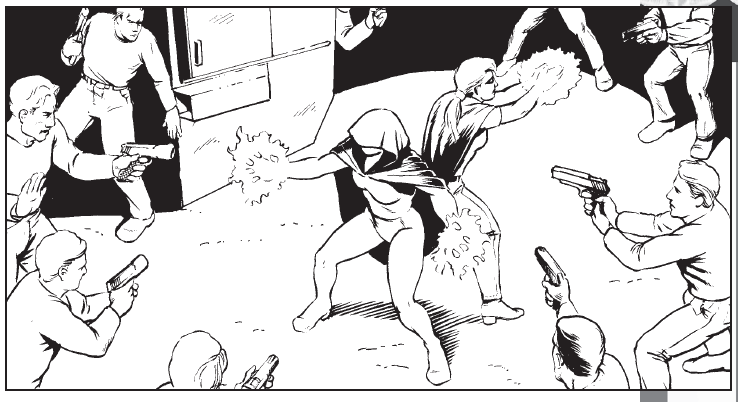
Loyal (3): You have to make a Spirit roll to deny a friend your help.
Lusty (1): +2 bonus to Persuasion if they like the fact that you're horny, -2 to the roll if they don't.
Mean (2): Even more assholery. You get -2 to good Persuasive rolls and +2 bonus to hostile Persuasive.
Mute (3)
Obligation (1/3): The higher one means the debt you owe is ongoing.
Obvious (3/5): Lesser rank is just "you look conspicious", higher is "you're quite obviously a Delta".
Old (3): -1 to Speed dice total.
Pacifist (3/5): Only kill when it's absolutely necessary vs. never kill ever.
Poor (3): Can't hold on to money, start play with just $100.
Poor Ears (2/4): +3 TN to Hearing Perception or absolute deafness. With a hearing aid, still +1 to TN.
Poor Eyes (1/3/5): Needing glasses, +3 to Perception TN, blindness.
Savage (3): Flip the fuck out if you can't make a Spirit roll when stuff gets tough. -3 to Smarts when freaking, +3 to Strength bonus, can only use a club.
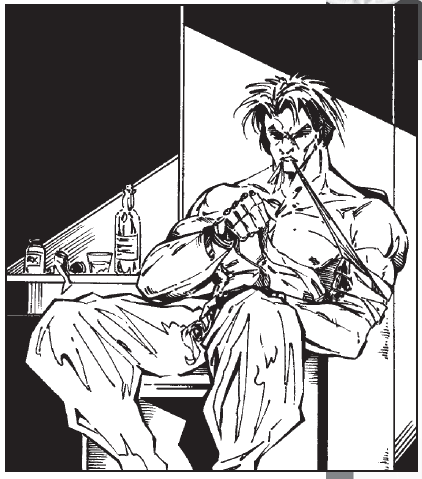
Self-Righteous (2): Holier-than-thou dick. -2 to Persuasion when people don't agree, +2 if they do.
Skeptical (1): +2 to resisting people's attempts to persuade you stuff.
Slow (2): -2 to Pace.
Slight (5): -1 to Size.
Snobby (1): Elitist dick. -1 to any attempts to Persuade people politely.
Softhearted (1): Make Spirit rolls to ignore people in need.
Stubborn (2): Pig-headed dick. Spirit rolls to change your mind.
Stutter (2): -1 to friendly Persuasion or make a Spirit roll to speak normally when shit is real.
Superstitious (2): Spirit roll to resist a -1 modifier to dealing with supernatural crap.
Squeamish (2): Bravery roll or run if stuff is gross.
Temper (2): Spirit roll to not react violently.
Ugly (2): -2 to friendly Persuasion, +2 to hostile.
Unlucky (5): You need one less 1 than normal to trigger a Disastrous roll.
Vengeful (2): You basically want to get revenge forever but there's no mechanical effect.
Vow (1-5): The more intrusive it is, the more you get back.
Wanted (5): Cops are comin'.
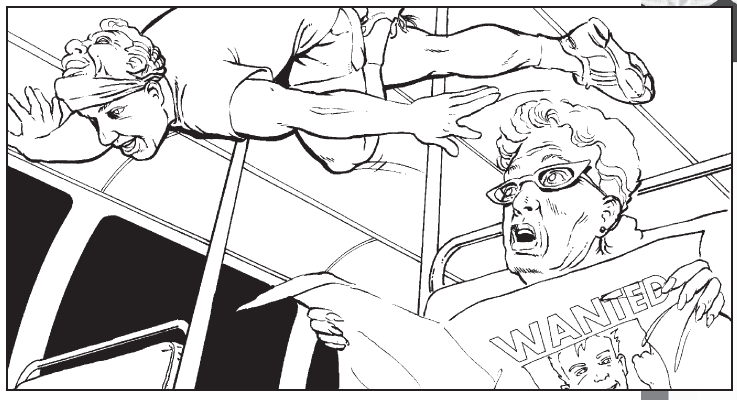
Young (1): -2 to any Persuasion because you're a teen.
NEXT TIME: We got us some game mechanics and also probably Tricks in Chapter 6 and 7. I hope you're ready for a clumsy initiative system.
Post
Original SA post
CHAPTER SIX: THE BIG THROWDOWN
HELL YEAH IT’S TIME FOR FIGHTING
So a reminder: the entire basis of the system is “roll xd6, explode any of the sixes and pick the number that’s the highest to beat the target number”. This applies to combat as well and it…ehhh. Note: I have to rearrange the order of presentations of some of these notes because it isn’t set up well/cohesively.
Before unexpected combat, you can be Surprised if you fail a Perception roll that’s TN 5-15 depending on how much you’re expecting a fight. If you fail, you can’t take part in that round until proper combat. Proper combat has rounds (5 seconds each) and at the start of every round there’s a TN 5 Speed initiative roll where every extra success gives you an extra action that round, up to your Speed. If you fail, you only get one action that round. You go in order of the highest result.
I made a mistake earlier with what I said because of Confusing 90s Terminology: I took ‘reg’ to mean ‘someone who is a registered Delta’ when it in fact means a Regular Person. ‘Regs’ get a max of 5 actions per round generated from Initiative Rolls while Deltas can have unlimited even though it’s in canon incredibly unlikely for a regular-ass person to have a Speed of 5. And then the next round you roll Initiative again.
You can do as much as you have actions but some actions require more effort than others because of course. Simple Tasks require zero actions and are mostly just moving, talking or defending to someone’s attack but have to be done on your turn (except for reactionary defense). Short Tasks are mostly punches and shooting and require one action and Long Tasks require two actions. It’s of course up to your GM to classify how many actions it’s going to take. You can also Hold Actions which is every use of Hold Action ever.
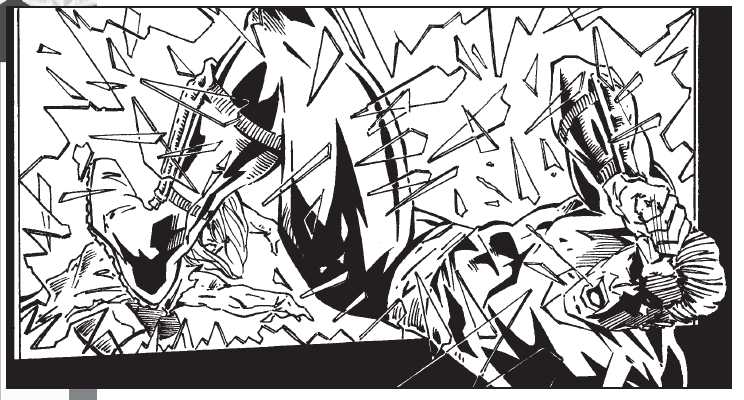
The black and white art is just really goofy or bland all around this time. This in particular is some Sin City shit.
You can move up to your Pace, which is that many inches on a map with minis or double the number for total yards. Again, a regular person can apparently move 42 feet in five seconds if they want to without sprinting (shh I am bad with visualizing or measuring actual distance shh). Sprinting itself is a Short Task and extends how far you can go by two yards per action dedicated to sprinting. At the end of a round of sprinting, you have to make a TN 5 Strength roll or be stunned with +1 to the TN per round sprinting. Ughhhh. Hey did you know Pinnacle sells 30mm metal minis? It’s true! Buy some!
Getting up off the floor eats 4 points of Pace and being on the floor sucks because you have -4 to Dodge. You can also Leap Forward a half inch for every point of Strength and speaking of Strength you can carry cumulative weight up to a Size equal to your Strength+2.
Alright let’s forget this boring D&D nerd stuff with leaping (3 feet per point of Strength) and junk to focus on the real thing you’re here for: attacking. Hell yeah.
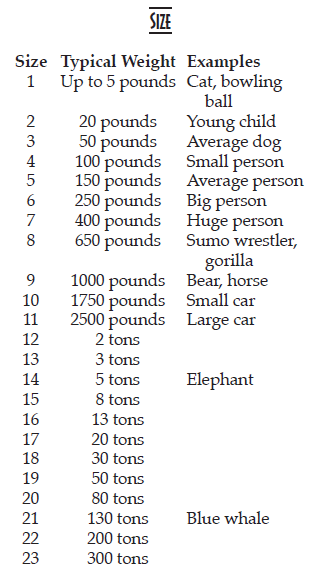
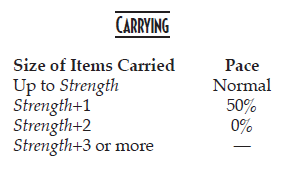
Size examples and lifting/carrying limitations.
To shoot someone, TN 5 with modifiers depending on circumstances. To hit someone in melee, the TN is 5+Defender’s Fighting/Fighting Weapon bonus. Hell yeah.
*cough*
I mean there’s more to it than that but…yeah that’s all it takes to fight someone and hurt them. This is me cutting out all the extra stuff so it seems simpler than it is. Let’s focus on ranged attacks first.
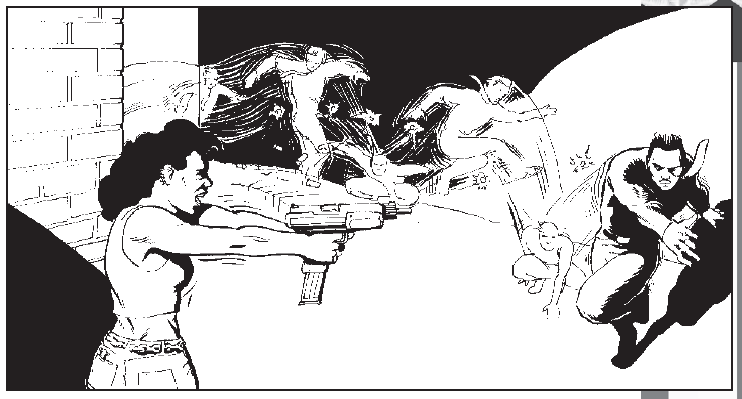
GOTTA GO FAST. It's interesting that, uh, the target not standing still doesn't seem to matter about how hard it is to shoot them.
If you can see the target/the target is hidden, you can shoot them. You need line of sight. Weapons have type, action (auto/not auto), ammo, shots (before you need to reload), quickness (how many actions it takes to shoot), rate of fire (if higher than 1, it’s auto), range increment (which has problems) and damage. On range increment: when you shoot someone who isn’t standing right in front of you, measure the inches between you and the target then divide it by the gun’s range increment. Round the number down and add it to the TN. The big problem with this execution is that it assumes you’re using miniatures. See how I said “inches” up there? If you’re not using minis or map (shame on you I guess, I personally don’t often do that) the GM just has to sort of spitball a number in feet/yards, convert it into Map Inches and figure it out. Alternately you could just multiply the range increment by 6 I guess. It’s just weird to see the range penalties for shooting be badly implemented to this degree.
Moving on: other ways to fuck up the TN because nobody stands in place shooting each other point-blank. These all assume you’re the shooter.
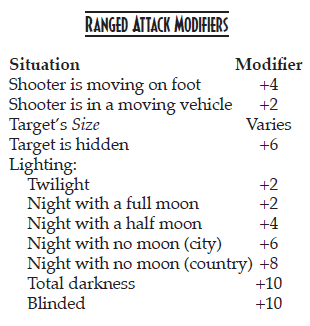
Hidden is an interesting state because it assumes completely hidden, crouched down behind something and the shooter is trying to shoot through their cover. Partial cover/regular cover is covered later. Size means you reduce TN to hit by 1 the larger you are over 5 and increase the TN by 1 for being under 5. The book has literally the exact wording written, meaning that as it stands according to the errata, it's harder to hit a bigger person
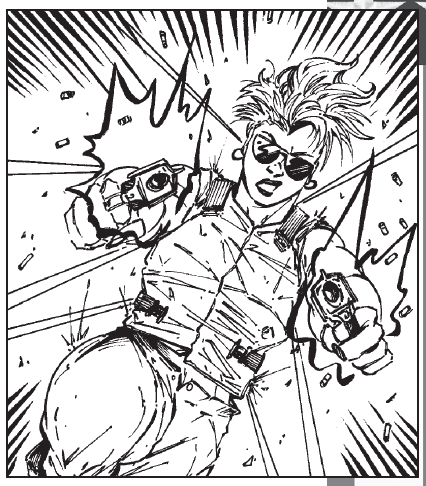
2 legit 2 quit firing everywhere jesus lady aim
Different Weapon Types: You can fire bursts up to the weapon’s rate of fire. Bursts add one extra die per bullet, every extra success you get on the roll counts as a true bullet and that’s assuming it’s all meant for one person. You can also aim and do called shots with automatic bursts. If you’re going to shoot more than one person with burst fire, if they’re within one inch (six feet) of the prime target you can assign an extra success to them as a hitting bullet or more depending on how far away they are. As was previously mentioned when talking about Target Numbers, you’re not likely to get more than two or three extra successes. If there are only two people, it’s a lot better to just use your normal actions and shoot one bullet at a time.
Shotguns are different. Damage depends on range unless it’s a slug round (adds +4 to TN due to “the poor way such a hunk of metal slides through the air”) which will always deal 5d6+15 damage regardless of range. Double-barreled shotguns can have both barrel fired at once with the same attack roll but with separate damage rolls per barrel.
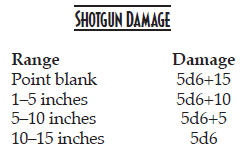
If you ever use a two-handed weapon one-handed, add 3 to the TN.
Ranged Combat Maneuvers: You can burn up to three actions per round to aim to lower the TN by 2 up to a total -6. You can make a called shot to a specific area by raising the TN. If you shoot them in the weapon to disarm them, they have to make a TN 10 Strength roll to hold onto it. You can shoot from the hip with a weapon of Quickness 2+ by adding the Quickness to the TN. You can’t aim a hip shot but you can try a called shot if you’re a big badass. You can also roll to Quick Draw to draw and shoot in the same action (TN 5) but if you fail you just draw and need another action to shoot. You don’t really need to have Quick Draw outside of one or two points; what you really need is Speed Load. Reloading has a set amount of actions to reload but you can roll TN 5 Speed Load where every extra success reduces reloading by an action to zero.
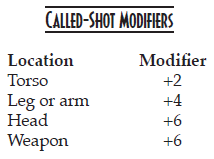
You can also dual-wield because hell yeah. Did you take Ambidextrous? Good, no problems with dual-wielding then. Otherwise, shooting with your off-hand adds 4 to the TN. Firing both guns at once leads to +4 TN which can stack with the off-hand penalty for a total of +8 TN so basically don’t bother shooting both at once without Ambidextrous.
To throw a ranged weapon, you can throw it up to your Strengthx10 inches. This means that the average person (2 Strength) can throw an item 20 inches/40 yards/120 feet. This is assuming a size of 1. Anything bigger than 1 (five-ish pounds/a cat) can be thrown Your Range divided by Item Size. So the average person who is Strength 2 should be able to throw a 20 pound item/small child 60 feet, right? Wrong! Turns out if you throw a thing with a Size equal to your Strength, you can only throw that item inches up to your Strength. So Jane Doe Average can pick up her five year old son Tim and throw him up to 12 feet max. But if Jane picks up her baby daughter Eliza, she can pitch Eliza 120 feet. That’s 3/4ths of a football field. Your range increment for all thrown items (regardless of size) is equal to your Speed which just adjusts how hard it is to hit your target. Since Jane is average, all of her Traits are at 2, so her Range Increment for throwing Eliza is 2. If she’s going to try and whip Eliza at her ex-husband, who is standing 120 feet away, that’s 20 inches which means it’s +10 TN to throwing a baby for a total TN of 5+10 for 15. So she could throw her kid 120 feet as long as she’s really not planning on hitting anyone intentionally because her stats are sort of shit, even if Jane used to have Olympic shot-put technique that gave her Throwing at 5. On the other hand, throwing Tim is a lot more accurate because she can only throw him 12 feet max which is 2 inches which is +1 TN for a total of TN 6.
Let’s throw something else besides children. Explosives are delightfully dangerous and they also run into the problem of “I assume you’re using minis and have not considered otherwise”. Explosive weapons have a Blast Radius, a Secondary Blast Radius equal to double the radius (take half explosive damage) and Tertiary equal to triple (take a quarter). You roll once and apply the damage to everyone unshielded around the area of explosion. If they’re right on the line between radiuses, they take the more damaging amount. I think this requires an example to truly understand its execution.
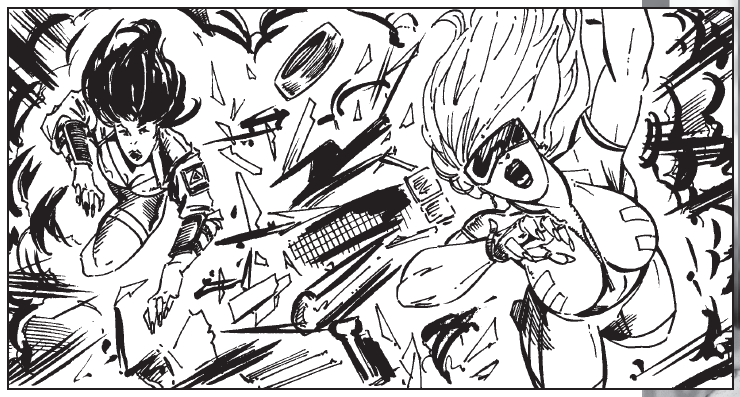
Looks like they're gonna have to juuuuump!
A grenade has a Burst Radius of 5 inches (which is 10 yards or 30 feet). Anyone within the 30 feet takes 10d6+10 damage (which I calculated for this example for fun and ends up being 27 damage). Anyone standing 31-60 feet away takes 13 damage. Anyone standing 61-90 feet away takes 6 damage.
This is assuming you didn’t fuck up your throw. If you roll mostly ones, you flat-out throw the explosive at your feet. If you just miss, you make where you’re facing directly be 12 o’clock, roll 1d6 and double the result for which point on the clock you’re throwing out. Yes this means if you roll a 3 that’s 6 and you can just throw it right the fuck behind you. Then you calculate how far you throw it. If the target is less than 10 inches away, roll 1d6 and that’s how many inches you throw it. For every solid 10 inches away, add another d6. If you throw it behind you, it can only go as far as half the original target’s range Jesus what am I typing this makes barely any sense. So basically if you fling a grenade behind you it's probably going to explode with you in the blast radius? That’s great. That’s just great.
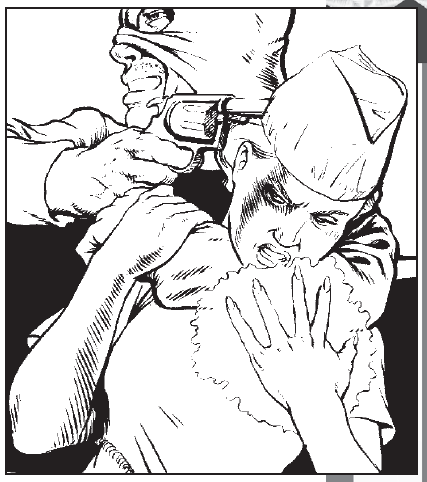

Hey kids! It’s the 90s! Let’s talk about the thing you all crave: collateral damage. If you fire a burst and there are people around, any bullets that don’t hit your targets are now stray bullets and can hit innocent bystanders. Anyone within 3 feet of the line of sight with the target can be hit on a 1 in a 1d6 roll. If the bullet doesn’t hit the first person in that line of trajectory from the barrel, roll d6s down the line and if it’s ever a 1 it stops because it hits a civilian/bystander. If you’re firing a shotgun at a target in a crowd, it hits a bystander on a 1 or 2 on a d6 roll. If the target is using a bystander as a human shield, then you roll for hit location on the target and if it hits something covered by the human shield, it hits the shield instead. Hooray. I am reminded of Kane and Lynch, which is never a good sign.
Alright so it’s time for close combat which is admittedly way less complicated but also less fun. As long as you’re within 6 feet (1 inch) of a target, you can use melee weapon attacks (or longer, depending on weapon reach) which strikes me as wacky to say the least. If it’s fists, you have to be up on each other. To hit someone, you need to beat TN 5+Defendant’s Fighting (or Fighting Weapon) Bonus+Weapon Defensive Bonus (if it has one/if you’re fighting with a weapon). You can Charge people and gain +1 to damage for the hit for every 5 inches moved (30 fucking feet!) up to +10 damage. If you have the movement to allow for 300 feet of charging (spoilers: guess who does? It’s Speedsters), you can inflict +10 damage with melee attacks on a charge. The big downside of charging is that the bonus damage is dealt to the weapon/your fists as well as the target, possibly breaking your arm or weapon in the process. Also, as you will see later, shooting someone is a better way to get +10 bonus damage than charging for 300 feet. You can also try to disarm weapons, rush attacks by adding the Weapon’s Quickness to the TN, attack with the off-hand or dual-wield but the same rules apply for ranged damage.
Finally, there’s dodging and I hope you put points into the Dodge skill. If you haven’t gone yet in the round, you can give up an action or you can give up a held action. If you have no actions left you can’t dodge, if you only have one action this round, tough. You can’t go this round. Declare a dodge before the attack is rolled and the result of your roll becomes the new TN before bonuses are added (if it’s lower than the normal TN of 5, the regular TN of 5 applies instead). With a minimum of 5 in Dodge, congrats! You can only raise the TN now if you dodge.
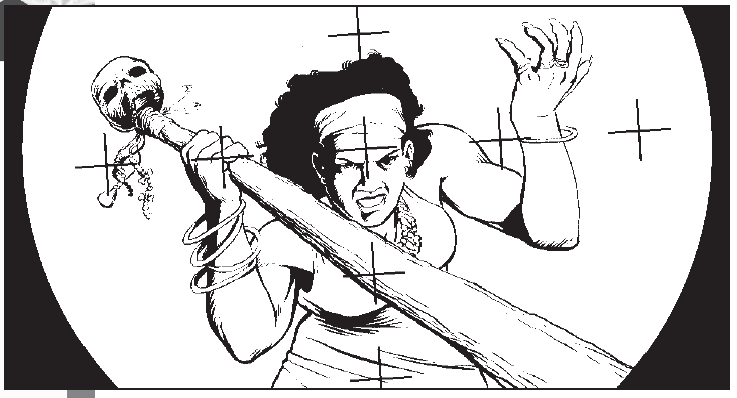
Absolutely zero context.
DAMAGE
When you hit someone and are not calling a shot, roll 1d6 with no explosions to determine where you hit. If the target is behind cover, the cover eats the attack like armor if it would hit where the shot was aimed (but can possibly penetrate the cover). If you’re prone, only your head and arms can be hit and that’s actually really dangerous.
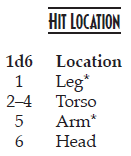
Dealing damage depends on the weapon. For a ranged attack, you roll the weapon's listed dice and add the weapon’s bonus damage. A punch is just a Strength roll. Using a melee weapon is a Strength roll and you add the weapon’s bonus damage to the result. If you hit someone in the head, add two extra bonus dice to your damage roll. You can also never have a disastrous damage roll, the ones don't matter.
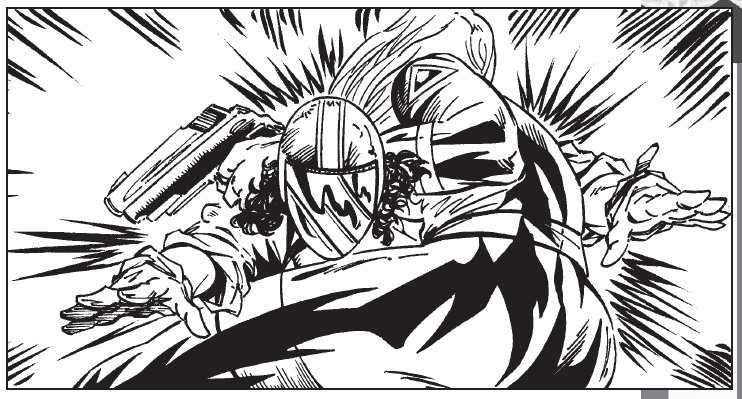
If you can't tell what's happening, the person in the helmet is getting kneed and elbowed in the neck simultaneously.
If the target is unarmored, take the result from the damage roll and divide it by size. That’s the amount of wounds dealt to the location it hit. Armor comes in two forms: deflects and absorbs, or deflects. D&A means it reduces the attack by a certain amount and then splits the wounds between the armor and the user. If it's an odd amount of damage, the user takes the majority of damage. If the armor's wound slots fill up, it no longer protects in that area until repaired/replaced. Deflective armor can just deflect a certain amount but the fact that it takes no wounds means it will never wear out. You can use shields to protect your arms and torso and they'll eat wounds first before your armor and your skin. If you're a cheeky person and layer your armor, too bad. You can only wear one layer total not counting armor granted by powers. You use the higher armor value of the two and if both your powers and worn armor absorb wounds, split the wounds as normal but your worn armor eats the wounds first. Armor piercing ammo bypasses as much armor as it says it does and if improvised armor takes 3x its absorbing value, it's destroyed rather than just compromised.
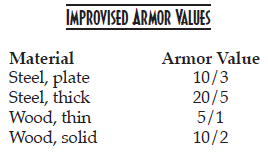
Wounds are how damage dealt is tracked. You have Wounds up to your Strength in each part of your body and when it's taken that many wounds, it's made useless. So the average person has 2 Strength which means they can take 2 Strength in each limb, torso and head. If the right arm takes 2 wounds, it's made useless. A useless arm can't be used for anything. One useless leg cuts Pace in half and two reduce you to a crawl. A useless torso or head means that the target is knocked out. When you're wounded, take the highest level of Wounds you've received to an area and add that to all TNs until healed. There's also the fact that the impact of wounds hurt. Every time you sustain a wound, TN 5 Strength check to resist being stunned, including the TN modifier of being wounded. What is stun? You can't do anything and you can't dodge or defend against anything. You have to beat the same TN in order to stop being stunned and recover. You can try once per round, but if you roll mostly ones you pass out for 1d6 hours instead unless roused.
If you take double your wounds, that limb/portion has been pulped. A pulped limb is shattered, severed or beaten to hamburger and at the end of every round you have to make a TN 5 Strength roll to resist bleeding out. Fail three in a row and you die. To stop the bleeding, you need a TN 5 Medicine roll. If the head or torso is pulped, they're stone cold dead. If you have a pulped limb, you have to make a Stun check every round.
Let's say you don't want to kill someone. You can do two things. First, use a Stun weapon which has a built-in TN for a Stun check the victim has to roll to resist if they get poked. They don't do any damage. Alternately, you could pull your punch. Pulling punches only applies to melee attacks or punches, you can't lower the damage of a gunshot. Pulling a punch means you can reduce your Strength bonuses for damage to 0 or reduce your damage dice to just 1 dice if you want, or as many dice or bonus as you like.
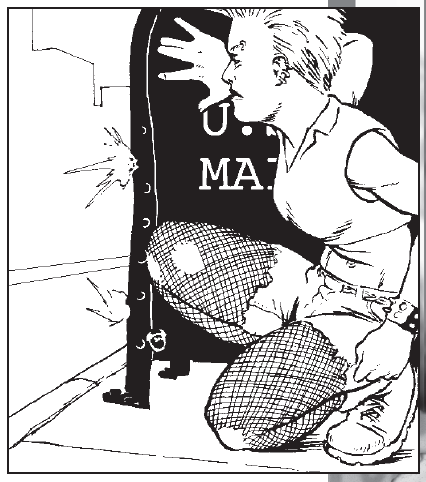
A mailbox: the perfect armor.
The counterpart to reduced damage is massive damage which is dealt to the whole body. Explosions, fire and falling from high places count as sources of massive damage. On the plus side, massive damage doesn't deal extra dice to the head. On the downside, if you're not wearing full body armor or have an armor power it won't protect you.
OTHER SOURCES OF DAMAGE
Drowning, suffocating or smoke inhalation require you to hold your breath, which you can do for 12 rounds with no problems. After that you need to make a TN 5 Strength/Swimming roll per round. Fail and take a torso wound. Succeed and add +1 to the next TN. If you pass out, you automatically fail holding your breath until you die.
Shrapnel is dealt from explosions in addition to explosive damage. Depending on where you are in relation to the blast, you can either receive 1d6 shrapnel, 1d6-2 or 1d6-4 (the dice, heh, explode in this case). Each piece of shrapnel deals damage, the average damage roll being 3d6+3 or depending on the explosive's stats.
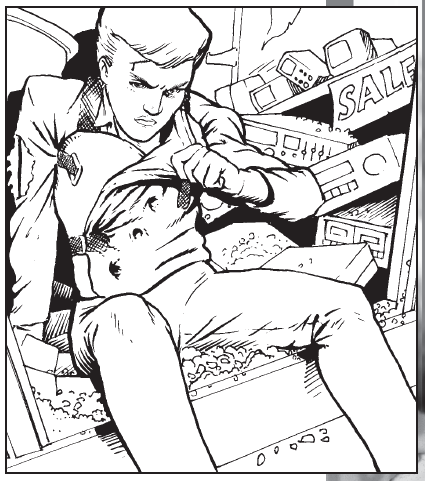
I think someone threw her into the window display of an electronics store.
Falling depends on what you land on. If it's a hard surface, every two inches/twelve feet you fall deals 1d6+3 damage up to 20d6+60 damage which means you've fallen 240 feet and managed to hit terminal velocity along the way. If it's water, cut the total damage in half. You can also attempt a TN 10 Speed roll to land with a dive and cut the damage to a quarter. Just make sure the water you land in isn't shallow.
Using an improvised weapon is confusingly implemented. Generally speaking, the damage is Strength roll+Item Size. If the item's size is 4 bigger than the target's, it's massive damage dealt to the target. Also if it's improvised there's a chance it will break (a 6 on a d6 roll).
Being in a fire deals both smoke inhalation damage and fire damage. Generally a fire on one part of your body deals 1d6+5 damage per round or being entirely on fire is 3d6+5 massive damage. Putting out the fire is TN 5 Speed roll for normal fire or around TN 15 for stuff like napalm.
HEALING
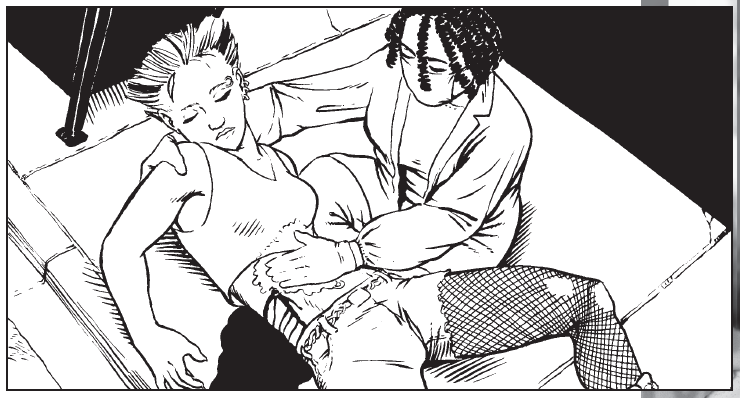
Let's say John Doe Average has been beat to shit by falling off a building and he took two wounds across his body and passed the fuck out. Every round he's KO'd, he can attempt a TN 5 Strength roll to wake up unstunned. If he wakes up, he can't do much more than crawl around or move around and keeps needing TN 5 Strength rolls to stay awake. Because he's a normal-ass person, he's probably going to dial the hospital on his cell phone and try to stay awake until the paramedics come.
Doctors have to focus on each part of the body individually but can only help you if you go within the first hour after injury. Healing done also depends on how much damage there is on the afflicted part of the body. Derek Everyman accidentally cut himself with a kitchen knife and has 1 wound on his arm so his doctor only has to make a TN 5 Medicine check to bandage his wound. But because John Doe Average has made all of his target locations useless when he fell off that building, his doctor needs to make a TN 10 check. Fortunately for both Derek and John, just one success is necessary to heal a single wound but has to be done location by location: one roll for Derek's arm, six rolls for John's everything. Derek can walk out of the ER with a bill and 0 wounds, but John is going to have to stay until he heals the remaining 1 wounds across his body. Lucas Soandso is shit out of luck, however; his leg got run over by a car and it was pulped. The doctor's can't do anything in the realm of mundane medicine to save his leg but his wounds still have to heal over time.
At the end of every full day you get bed rest, make a TN 10 Strength roll. Every success heals 1 wound in each hurt location. If John makes that healing roll, he'll be out of the hospital in no time. Alternately, he could have called his ex-wife to pick him up and he could've just healed the damage by spending time in bed instead of going to the doctor. Let's not kid ourselves: real medicine doesn't apply here.
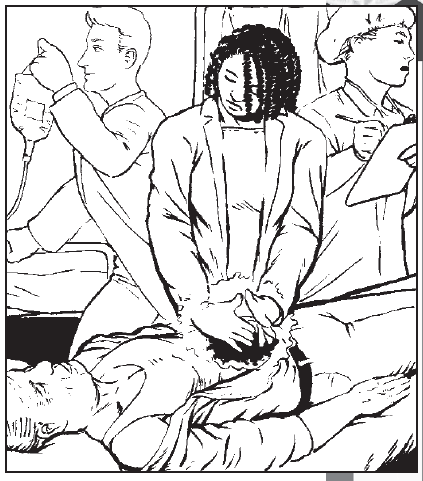
There's also healing powers but those are a separate kettle of fish we'll get into when we get to powers.
VEHICLE RULES
Ugh of course there are rules for cars. Alright let's get this over with.
Cars go first in combat but you can always spend a dodge to dodge a vehicle whenever. Cars actually have four stages of Pace: stopped, quarter Pace, half Pace, full Pace. Per round, it can accelerate 1 Pace stage or decelerate 2. Either way, each round it MUST go the full amount of Pace required for that round or crash if the driver can't make a TN 10 Driving roll to quickly decelerate. You can turn 45 degrees per round with no problem but each turn after requires a TN depending on vehicle and an action. Each turn after the second adds +2 to TN, a 90 degree turn is +3 TN period and the car's driving modifiers get added to turn TNs. Fail the driving roll to turn and you just go straight with no more turn rolls allowed or crash on a disaster. You can also spend a held action to attack while driving, be it drive-by shooting or ramming with the car or attack a car driving by you.
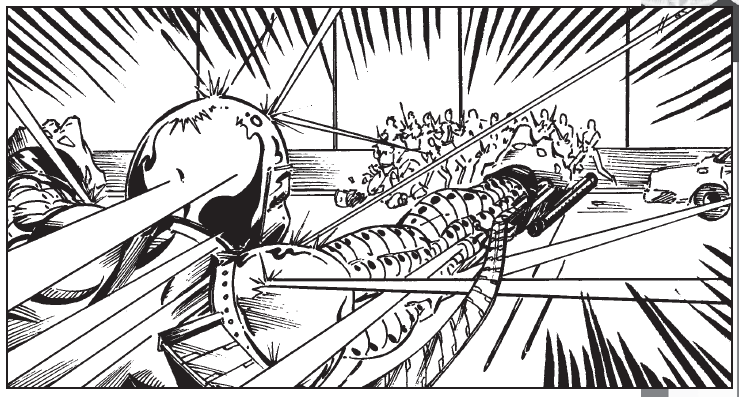
There are no pictures of cool car stuff going on in this chapter so have this.
Let's talk about dealing damage with a car: it's asinine. When a vehicle crashes, it takes 1d6+5 damage per 5 Pace it was moving. If it hits a person, that person takes the damage as massive damage. But say two cars collide. I'm gonna quote this example almost verbatim: "figure the damage using their relative speeds. If two cars hit each other going 45 and 65 MPH, that's 110 MPH total". Relative to what, Pace? If that's the case, both cars have to roll 22d6+110 damage received which makes way more sense than figuring out how to convert MPH to Pace (because that would be 880d6+4400 damage). It's just an arbitrary sort of figuring out how much damage it does, it's very much not clear as written. Cars also have Durability which is two numbers divided with a slash: the number of wounds the car can take and how many wounds the car takes before you add +1 to all driving rolls because it's beat up.
CHAPTER SEVEN: Tricks of the Trade
Tricks are things your characters can do to get an edge in combat. You start off knowing three tricks and they can be from a list of Tricks related to your Power, Combat Tricks or Trait/Skill Tricks. I'll be going over the power tricks later when we look at each type of power set.
COMBAT TRICKS
Bull's Eye: For the cost of an extra success on an attack roll, add 1 or remove 1 from your result on the Hit Location Table, spending as many extra successes as you want. Or you can switch to the opposite limb. This is actually rather handy for when you want to try for a headshot but don't want to risk a called shot.
Entangling: Tie people up nonlethally with certain weapons, forcing a TN 10 Speed/Strength roll to get out. I guess without this you're sort of just beating on someone with a bit of rope or trying to whip them.
Extra Damage: Spend extra successes to add another dice to your damage roll, 1:1. For any attack. Any attack. There is nothing saying you can't apply this to guns or explosions somehow.
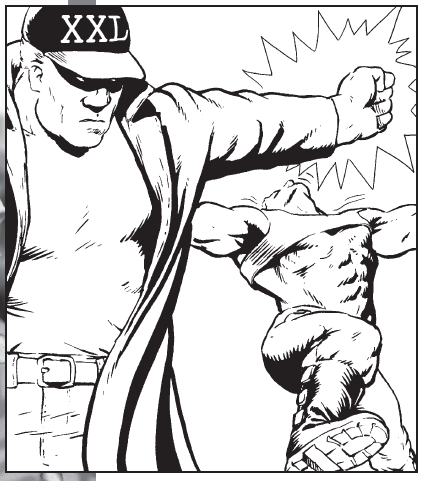
Clotheslining is not a trick you can learn, even if you do make a delta pro-wrestler.
Grapple: God in heaven help us. With a spare success in a blunt weapon/barehanded attack you can auto-grapple. Roll hit location and damage normally and roll Strength damage to where you're grappling (you still get bonus dice for squeezing someone's head). To escape, the grapplee has to beat the grappler in a Strength roll, the Strength damage auto-inflicted as long as they hold on. Okay all things considered these aren't that bad for Grapple rules.
Knockback: Spend extra success to knock someone back 12 feet per success spent. If this knocks them against a wall, Stun check even if it doesn't wound. You can also totally knock someone into spikes, fire, off a building...
Knockdown: Spend an extra success to knock the target down.
Ricochet: Spend an extra success to bounce a ranged attack off the target with +4 to TN to hitting the next target. This can continue as long as you get an extra success to spend and the TN penalty is cumulative. You can also use this to bounce the attack off something hard to bypass cover for the same TN penalty. Unfortunately the ricochet has to "make sense" so it might bounce off an armored chest somehow but if you just shoot someone in the chest it apparently can't just bounce. I guess just start whipping spiked baseballs at people.
TRAITS & SKILL TRICKS
Brilliant Idea: When using Raw Smarts in a roll, spend an extra success to get a hint about something you're overlooking.
Fast Learner: When rolling for an unskilled Smarts roll, get 1 free rank in the skill you're substituting Smarts for with 3 extra successes.
First Move: Sacrifice one of your extra successes on an Initiative roll to..."use any or all of your remaining actions when your turn comes around". What? I'm going to link this whole thing raw, I have no idea what this is saying. There is absolutely nothing stopping you from using all of your actions at once when it's your turn per round.
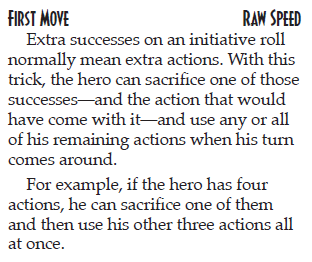
Edit: thanks to Moinkmaster for making me go back and read the rules for initiative. You take one action at a time and keep looping until the round ends so this lets you just take all your actions at once. Which isn't so bad.
Know the Streets: With an extra success on Streetwise, gain Area Knowledge 1 of the area you're in for free, permanently.
Make An Impression: When using Hostile Persuasion, spend extra successes to earn a permanent +2 bonus against that person in the future.
The Natural: Fast Learner but 3 extra successes for an unskilled Speed roll skill.
New Friend: Make An Impression but with Friendly Persuasion.
On A Roll: For each extra success on a Spirit roll spent, lower the TN for the next roll by 2. This is apparently any roll.
Pumped Up: Spend extra successes on a raw Strength roll to increase carrying and lifting capacity by 25% up to 200% for 1d6 rounds (dice explodes).
Thoughts on Combat: Cheesing physics/combat rules with powers doesn't mean shit compared to an IED or a handgun.
Thoughts on Tricks: Man some of those are kind of fucking useless or only really helpful with crazy, crazy rolls. A lot of the Powers tricks are legitimately useful so that's good at least.
NEXT TIME: The nitty gritty look at the power packages and what exactly you get when you become one of the ten default Deltas.
Post
Original SA post
CHAPTER EIGHT: WHAT MAKES A DELTA A DELTA
There are ten different packages for a Delta to pick except if you want to make your own power package because why the fuck not, let’s say that here and now (please send us your power packages if you make them and they’re good). See below for rules about making your own powers (send them to us please).
There are also zero Alpha power packages included because ha ha maybe in a later book, who knows. If your character dies, oooooh maybe hold onto the sheet, you don’t know if they’re really dead but make a new character and hold onto the sheet just in case.
BARGAINER
Bargainers talk to demons, summon them and force them to put their powers into a totem item to call upon their powers by cutting a deal with them. Their main power is pretty much just being able to hear the voices of demons and call them. Bargainers are vastly different from the other deltas for two big reasons: there’s an order of Bargainers who have probably trained you with how to use your powers and they were started by the first Bargainer, Harry Houdini. So if you’re a Bargainer, you are literally a stage magician. The other big reason is that because you were trained by the order, you have skill requirements in order to be a Bargainer: Academia (Occult) 3, Escaping 2, Performing (Public Speaking) 2, Sleight of Hand 3.
Bargainers can have as many Totems up to their Spirit stat but can only be used one at a time. Totems have to be bigger than a pistol and visible in use (so like a wand, gigantic bling, a mask, actually a totem mask would be rad). It has to be made of jewelry, wood or stone. You can only use a Totem you’re attuned to and you start play with just one. If you lose a Totem and need to remake one, it takes a week of preparation and crafting capped off with a TN 30 Spirit roll. To attune someone else’s Totem to you, TN 20 Spirit roll and three days of prep. There are no actual rules for making a new totem (in this book, that is. The Bargainers sourcebook hasn’t come out yet at this point in time).
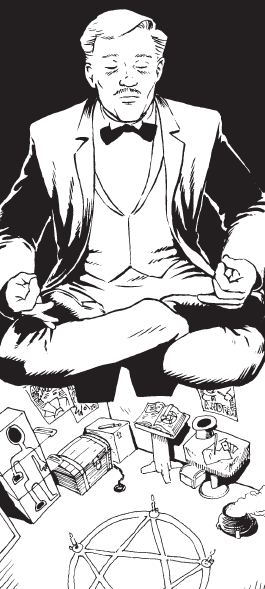
Dear Satan, get me off the ceiling please.
There are two types of Totems provided in this book, the Mimic Totem and the Delta Totem. The Mimic Totem lets the Bargainer mimic another delta’s power set with some rules. First, you have to touch them with the totem and if they’re not conducive to being mimicked, it takes a close combat roll and an opposed Spirit roll. Second, you get the whole package, no choosing parts, but only for one hour. Third, it can only mimic one package at a time. Fourth, if you lose the Totem while copying the powers are gone and they don’t come back when you get the Totem back. The Delta Totem is just one power set bound to that Totem (like say flight). It lasts as long as you want it to, but it’s only that power set.
Their main power is Bargaining (call demon, use them to create totem) and get the following Tricks they can choose:
Jinx: Using extra successes on an initiative roll and a contested Spirit roll, make an enemy lose one of their actions.
Make It Look Easy: With an extra success on a TN 5+ roll, you do what you’re doing with style, adding +2 to attempts to persuade anyone watching.
Other Tricks: Learn tricks for any power package you can imitate but you can’t do them without the totem being active.
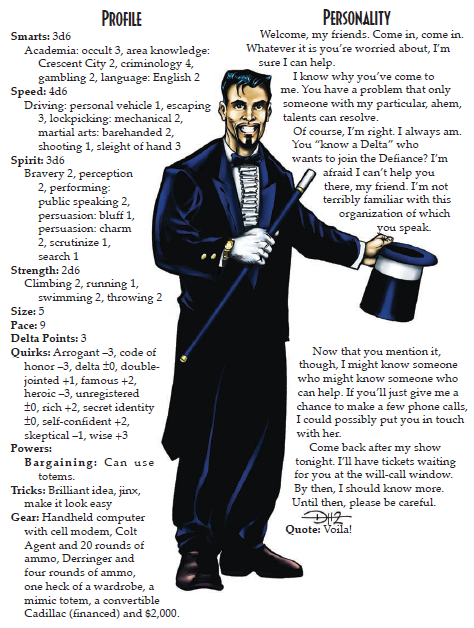
Ladies and gentlemen, nothing up my sleeve but this promo flyer for my NEW SOLO BOOK!
Thoughts on the premade character and the Bargainer: Jesus fucking Christ you’re the first hero in the book and you’re a fucking mess. First of all, you don’t fit tonally in the slightest compared to the other deltas and as a result what the fuck is it that you do. You’re a shitty Rogue from X-Men/Parasite from Superman dressed up as Zatanna or you’re just a guy who can become a different guy when he needs to be that different guy but only that guy. You can either theoretically be any other delta for only an hour at a time as long as you can touch them, or you can enhance yourself in one way only. And if you don’t take the first one boy I hope you like being a one-trick pony because second, you can’t make any new Totems according to the book as-written. If you lose your Totem, congrats! You’re fucked!
Let’s take a specific look at the premade character. He’s equipped with guns he has bare-minimum training with and doesn’t have a lot of ammo for. He is only slightly better at doing kung-fu. What can he do well? Criminology and escaping. This is just… ugh. He’s spread very thin and is definitely in a Master of None situation, especially because he has a Mimic totem. He’s not even really particularly excellent at being a face. He brings nothing helpful to the table besides that computer and his money and he can’t actually hack or do anything notable with this computer. Ostensibly he’d also be good at supernatural shit but the rules and world for that just don’t plain exist at this time.
The final main problem with the Bargainer is that I want you to look at how much I spent explaining what the Bargainer actually does. They have substantially more depth, info and attention than any of the other Deltas whose powers can be summed up by their name. There’s just so much stuff to them that doesn’t amount to shit and the Bargainer is the biggest hint at feature creep to come.
BLASTER
Blasters are walking, talking weapons. They shoot energy blasts from their hands and the source of power that lets them do this also gives them a skin-coating energy shield. Boom, fucking done. That’s it to Blasters.
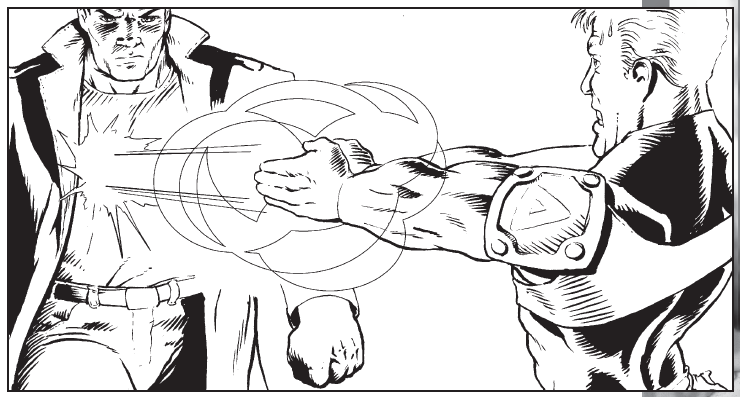
Blasters get the powers Armor: 5/- (which means they reduce all damage by 5 across their body but their armor doesn’t absorb wounds) and Energy Blast that they need Shooting to fire. Energy Blasts have unlimited ammo reserves, don’t need to be reloaded, take one action to shoot a blast, have a rate of fire of 3 (for up to 3 shots per attack), has a range increment of 10 and deal 5d6+10 damage per blast. Energy Blasts ALSO ignore armor unless it’s part of their skin or their powers.

This is really fucking good. Your energy blasts have the range limitations of a rifle, burst-fire like an assault rifle, shoot faster than a rifle, fucking pierce armor 90% of the time and hit like a .50 caliber bullet. Now, granted, you’re supremely lethal. You can’t hold back the damage in the slightest. But oh man there’s more to Blasters because there’s still Tricks.
Superblast: Spend an extra action per round to gather energy for a single blast, adding +5 to the damage bonus per action spent up to +20. You also need to use an extra success on the attack to initiate the superblast. If you’re stunned while charging, it’s lost.
Blast Punch: With an extra success on an unarmed punch, deal Strength roll+15 damage with the punch. That’s hitting harder than a chainsaw. Literally no other melee weapon comes close to that damage. You can also Superblast a Blast Punch, which is fucking insane and costs two extra successes to do and follows the same rules as Superblast.
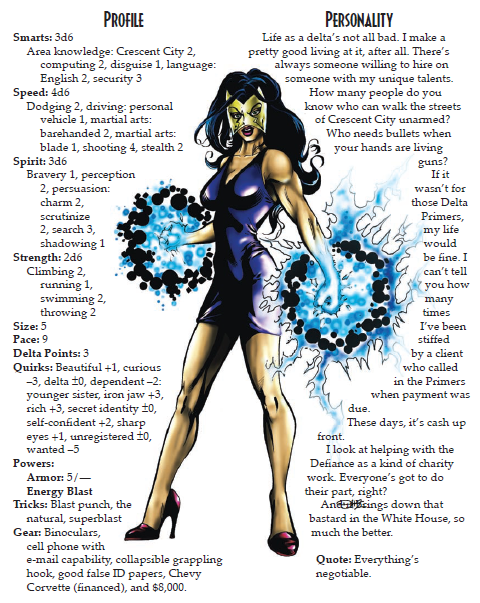
She's got the touch, she's got the power.
Thoughts on the premade character and the Blaster: Have you ever wanted to play an earth-bound Super Saiyan by way of a City of Heroes Blaster? The Blaster is for you! Actually I seriously wouldn’t be surprised if this ended up inspiring the City of Heroes Blaster to a certain extent because they get melee secondary powers. I like the Blaster; I sincerely like how bugfuck powerful it is. It gets some decent armor that makes them immune to getting wrecked immediately by another Blaster and energy blasts are hilariously good and powerful.
There are some problems with the premade character but as a whole she’s decent at what she’s supposed to be doing: blasting. Shooting at 4 is a good choice, she can at least Dodge, she’s got some ability to actually find things she’s looking for. She could be better, though, and I honestly mean that. First of all, she doesn’t even come equipped with a knife so why have Martial Arts: Blade when she has Blast Punch. Drop that, beef Martial Arts: Barehanded to Blast Punch together. Second, drop The Natural because that’s incredibly limited and situational. Replace it with First Move so she can drop an extra action and charge all of her Superblast shots in one go on her turn to fucking nuke the next thing she shoots. The main downside of Superblast is if someone interrupts you while you’re doing that as actions cycle, you lose that charge. First Move is wonderfully imbalanced for a Blaster.
BOUNCER
The Bouncer has augmented speed and strength and knows how to use it. It’s honestly a nice little package and I wouldn’t call them the Bouncer but they have a reason for it. Most Bouncers prefer to use melee weapons or their fists.
Bouncers get +3 bonuses to Strength rolls and they also get +5 to Pace and Speed rolls for Initiative and Dodging. Their Tricks are:
Bounce Attack: Use an extra success on an attack to leap off the enemy and attack another with +6 to TN. This is all the same action and if you get ANOTHER extra success on that next attack you can bounce again with another +6, the TN adjustment being cumulative.
Flip-Toss: Use an extra success on an attack to flip and pull your enemy with the momentum, throwing them into their air with 6 feet for every point of Strength the Bouncer has. If the enemy fails a TN 10 Strength roll, they hand on their back and take the Bouncer’s Strength in damage plus damage from what they landed on.
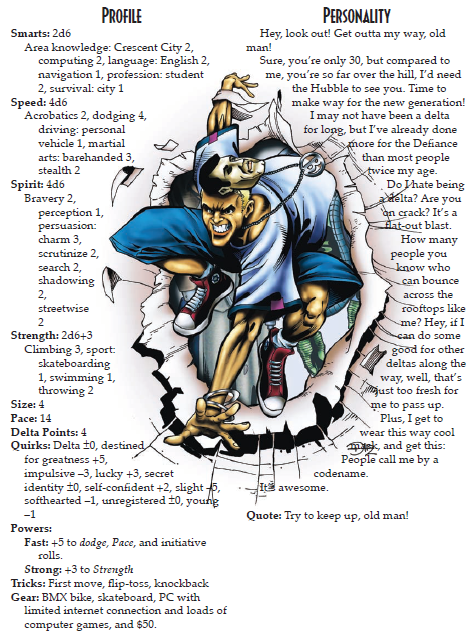
Til a Delta comes along on a mission and yells BITCH!
Thoughts on the premade character and the Bouncer: So basically they’re Bouncers because they homing-attack from target to target like Sonic the Hedgehog or flip them like Spider Man. The main problem with Bouncers is that…melee fighting isn’t the best way to cause damage or defeat enemies when you consider how you just deal Strength Roll damage with your bare hands. Hitting people isn’t the problem, hurting them is. Aside from that, they have a really good edge in the form of Dodge and Initiative. They can’t fail initiative rolls and can only get extra attacks and they’re harder to hit, period. That’s pretty good.
I can’t scrutinize the premade Bouncer too much. I would enhance their Strength more and lower Spirit, they’re an annoyingly-written character dressed like the lovechild of Eminem and Jim Carrey, they need some armor and most of their gear is just useless. What’s nice is they took the Bouncer in a way I’d take them to give them more of an edge in combat. First Move is a good choice and so is Knockback for Tricks. I would take Knockback and Flip-Toss and give them a focus on Speed and Strength to flip people up in the air and knock them off of high places. That way they take massive damage from falling and deliver wounds across the whole body, just punt people off rooftops in the name of justice.
FLYER
Uh. Fly. You fly because an energy around you allows you to fly. You can stop immediately, zero-point turn, hover, walk on sunshine, do whatever you like up in the air. There’s really not much going on. You can fly and you can fly well. That’s it. If you ever try to carry too much while flying, you immediately just plummet.
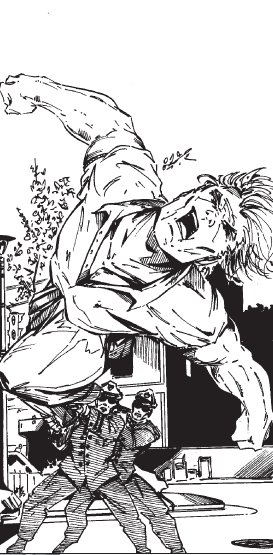
I'M SO MAD ABOUT FLYING
Flyers get Armor 5/- as long as you’re flying and you can fly at a pace of 50. This means that when you’re flying, you can just fly 300 feet a round. For Tricks they get:
Burst of Speed: For the cost of an action, you can turn extra successes on a TN 5 Flying roll into +10 Pace apiece for one round.
Flying Dodge: Extra successes on a flying roll or a dodge roll in the air can be spent to add +3 TN to any attacks against them for the rest of the round.
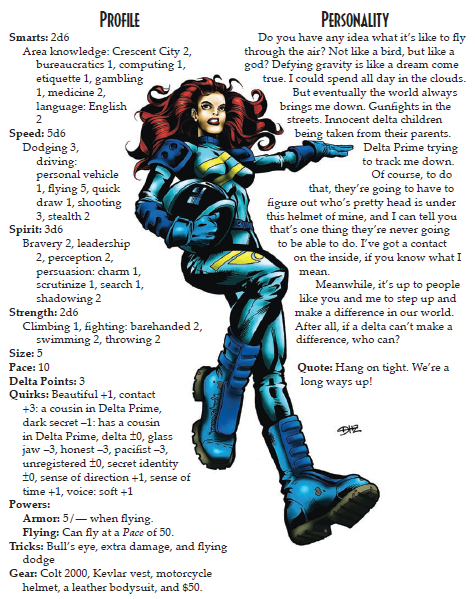
Tracks 1 and 4 on the Space Jam soundtrack.
Thoughts on the premade character and the Flyer: You are a one trick pony and it may sound like I’m being kind of hard on the Flyer for being able to just fly. I am. This is because unfortunately there really isn’t too much to the Flyer in the book! But the thing about flight in tabletop RPGs is that hey, you can now operate in a 3D plane as much as you feel like. You can fly where the fuck ever within 300 feet. You can fly to a position where you can penetrate an enemy’s cover. I would argue you don’t even have to roll to use a grenade, you can just drop it. You have only one mechanical advantage over all other deltas and it’s a big one, even if it doesn’t make you an accurate murder machine.
Unfortunately the premade hero is kind of as bland as the presentation of the power set. At least she has Flying 5. She can shoot but doesn’t want to hurt people and she can punch even though she’s way safer being up in the air. She can at least do some spotting and exploring and at least her gear makes sense.
GADGETEER
Gadgeteers are like Genuises. They can build things that tweak the laws of physics (not break) but they also have to maintain their creations. They really should be the most broken class in the game, as per any tradition where you have an item-creating class, but.
Every 24 hours, the Gadgeteer has to make a TN 5 Tinkering roll and one hour of time to keep it going for another day. If it’s not maintained, it becomes useless and needs eight hours of reworking and repair to make it work again. The game says that size of the gadget being maintained doesn’t matter, so as a result most Gadgeteers just load all of their toys into one creation so they only have to maintain one gadget a day. Fixing a damaged gadget requires four hours and a TN 10 Tinkering roll to repair a single wound with extra successes lowering the hours to a minimum of one.
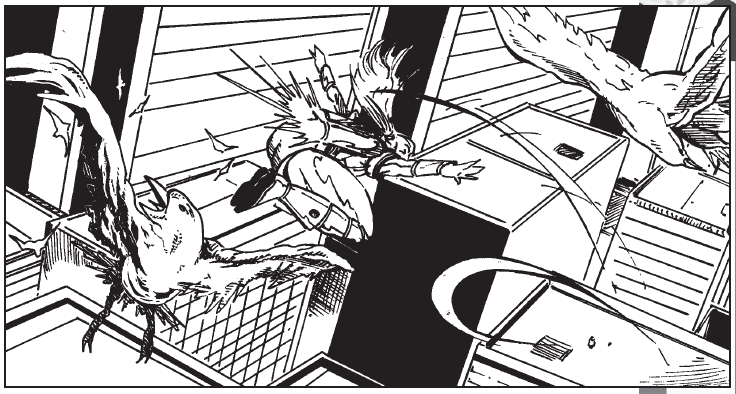
So let’s say you want to make a gadget. Do you like power armor? I hope you like power armor. There are stats for power armor. There are no stats for anything else that aren’t guns on your power armor. First, the gadget has to just bend physics or allow the amazing, not break it. Giant death lasers are explicitly off limits. Any weapons on the gadget should be as powerful as a weapon you could buy, if it would let you mimic a power of another delta then it shouldn’t let you be more powerful than the average delta. You definitely can’t make something that should let you be an alpha. Finally, the GM ultimately can say if you can make the gadget or not. In a stunning bit of GM advice advises you to just let a gadget break/fail at a dramatic time if you feel it’s too powerful or breaking the fun of the game. “Word of advice: don’t get too attached to those gadgets you come up with. You never know when they’re just going to stop working for no reason under your control”.
Power Armor is fucking heavy and needs a big car trunk or steamer trunk to carry it around. It takes six actions to put on. On the plus side, it has a jet pack that lets you fly at Pace 40, dual wrist-mounted guns, armor 10/3 and +3 to all Strength rolls when it’s worn.

For powers, the Gadgeteer gets Gadgeteering, the ability to build and maintain these items. For Tricks, they get:
Fine Tuning: Burn extra successes on a Tinkering roll to stave off maintenance by 24 hours per success.
Smack It: If your gadgets stop working, beat it and make a TN 5 Smarts roll. Every extra success keeps it running for one round.
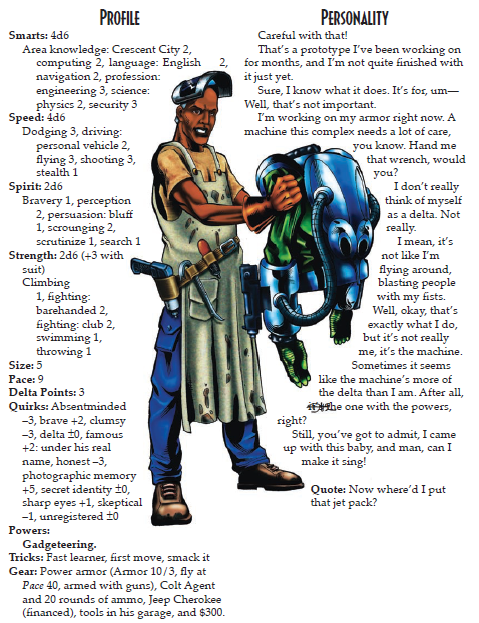
With that hook light on the stairs, what's he building in there?
Thoughts on the premade character and the Gadgeteer: This is probably one of the laziest implementations of an item maker I’ve seen in a while. It sidesteps the idea of having a thousand gadgets and selling them to make money forever but then it bogs you down by having literally zero things with stats you can make besides power armor. You’re like a Bargainer with the ability to get your new shit together if it breaks or is lost. You are half of an idea, an unfinished character class where you get handed to a player and the player is told “alright do whatever I guess unless I don’t want you to do it”. I cannot sincerely recommend you take this character class because it’s just there and not doing anything interesting. Plus power armor is okay, sure, but it feels like you’re just trying to do everything at once and spreading yourself thin with it but not actually being the best. The more you cram into the armor, the more it sounds like one of Justin Hammer’s idiot robots from Iron Man 2: trying to do everything but not being particularly good at it.
For the character sheet: nice spread of skills to do stuff and do actions. Fast Learner is situational at best, First Move really isn’t the best thing for your class, why the fuck didn’t you take Fine Tuning it’s the thing that alleviates your goddamn maintenance issues. You literally have zero points in the most important skill for your class: Tinkering. You have to make UNSKILLED ROLLS because you’re a goddamn engineer but this isn’t engineering, it’s super-powered pseudo-science. I can’t call this premade character useless because at least it has 4d6 Smarts but it’s damn near close to useless.
GOLIATH
You’re big, you’re strong, you’re ugly, and you’re slow. The average Goliath is around 8 feet tall and 400 pounds of muscle and armored skin. You are 100% the most noticeable type of Delta on the street and this is game that kind of wants you to be unregistered and fighting the power so hey that’s…fun.
Because Goliaths are stronger than the average delta, they get some installed drawbacks because they get 3 powers. Goliaths get Armor 10/-, +2 to their Size and +5 bonuses to their Strength rolls. For Negative Quirks they get Obvious, Ugly and Slow (-2 to Initiative rolls). For Tricks they get:
Rock Your World: Punch the ground with a TN 5 Fighting: Barehanded roll to knock people to the ground if they fail a TN 10 Strength roll. With a regular success, this effects people 12 feet away and you can burn extra successes to keep extending the effect radius by 12 more feet.
Superjump: With a Strength roll, jump 12 feet in the air and 12 inches in any direction. Every extra success adds 12 more feet for both directions. Landing on an enemy counts as a charge and if you’re 4 sizes larger than your target, the impact deals massive damage.
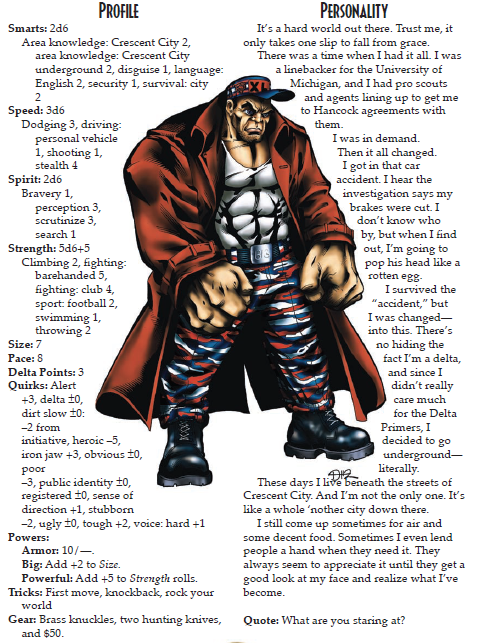
Yare yare daze, y'all, mah name is Jimmy John Joestar from Any Town, USA and I'm here to beat up DIO for the troops!
Thoughts on the premade character and the Goliath: Unfortunately for our friend the Goliath delta, they are in a game where Speed rules everything around them. It doesn’t really matter how hard you hit when extra actions are king and guns can fire up to X bullets for just one action. Strong Hops are cool, I’ll admit, and so is being able to just ground-pound. Also frankly making ALL Goliaths ugly is just plain ol’ bullshit because people still wanted to fuck The Thing. The other problem is that being eight feet tall and four hundred pounds of muscles is a pretty clear RP/IC reason for the GM to just hassle the fuck out of you and the other PCs because you’re totally a delta and do you have papers.
As for the premade Goliath, he’s got a good grasp on keeping an eye on his environment and he’s got his muscles and punching maxed. He’s pretty functional and equipped to do what he does well. My one complaint is: why does he have knives if he has no skill with using them?
GUNNER
You shoot people until they’re dead. You’re really good at shooting people. The game says that you’re probably not going to get arrested for being a delta but for using a gun to kill people. There’s really as much to say about the Gunner as there is the Flyer.
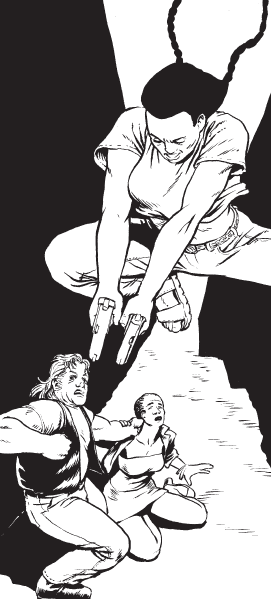
Welcome to the wrong end of the Surprise Round.
Gunner powers are +5 to all Shooting attacks and +5 to Speed rolls for Initiative. Their Tricks are:
Mercy: Pull your…bullets. Use an extra success to limit how much damage you do with a shot by defining where the bullet goes. Roll damage, apply stun to the target and then cut the actual wounds they receive by half.
Pierce Armor: Spend two extra successes on a Shooting roll to find a weak spot in their armor where the armor does not protect them from the bullet. This has the caveat of, verbatim,: “It’s the Guide’s call as to whether or not the foe’s armor actually has a weak spot. If not, the trick does nothing.” Translation: if the GM doesn’t want you to be able to pierce armor, fuck you it doesn’t.
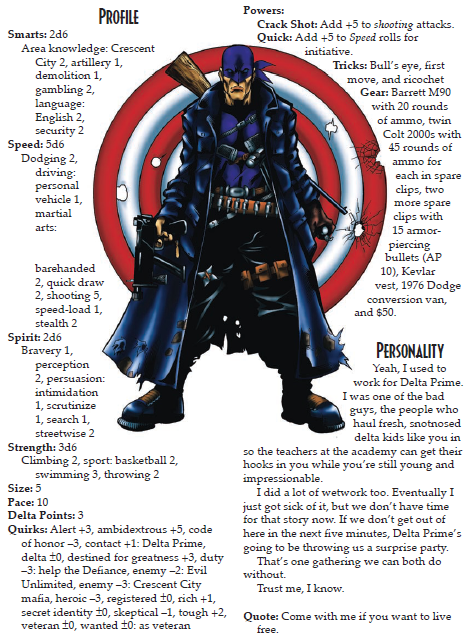
Someone call Bono, his guitarist is missing.
Thoughts on the premade character and the Gunner: The Gunner is tied with the Blaster for most dangerous Delta, limited only by ammo and needing to reload. You have a higher chance of getting more actions per round, you can just plain beat the normal ranged combat TN without putting any points in Shooting and it’s easier for you to make called shots. Because Dex rules the system, the Punisher is stupid deadly and effective. You can just bust out a fuckload of bullets and put your enemies down with no sweat before most people react.
This premade character is probably one of the few times you will see this kind of person drawn unironically by someone who is not a teenager. He is a goddamn murderhobo and he is actually built to murder. He doesn’t even have the Trick that lets you not hurt people as much. He lives in a van full of guns! Hell, his whole bio is about how much he murders people and how he’s still murdering people but for good this time. What gives him an immediate edge over the Blaster is the fact that he can dual-wield with less problems than she could. It’s just so over the top and straight, look at him. If I was to make a change I’d replace Ricochet with Pierce Armor; everything else he has is pretty well in order.
HEALER
Healers have to lay hands on people to make their wounds go away so some are doctors and some are shamans. Healing powers work different than normal medicine. It takes a TN 5 Medicine roll so it’s literally impossible to not heal someone somehow. Each healing attempt takes a minute. For every success on the medicine roll, one wound on the victim is healed from any location. However, any wounds that remain from the session cannot be healed by another use of anyone’s healing power. Those wounds have to heal naturally or through standard medicine. If you have 5 wounds, and the healer can only heal 3, you have to either get bed rest or go to the doctor to get the other 2 wounds healed. Also, knowing the human body and having a medical education makes your use of your powers more effective.
The power Healers get is literally just +10 to all Medicine rolls. For Tricks they get:
Healing Disease: Specifically trying to heal disease requires you to get X many total successes. If you don’t make it, you can never heal that disease with delta healing. If you have the Illness quirk, pretend you saw a Healer in the past and they couldn’t heal you.
Healing Poison: Get X successes, heal the severity of poison.

Your life is in her hands.
Thoughts on the premade character and the Healer: The hiccup of “it only works once” for healing powers is a nice complicated touch and I sincerely do appreciate it. I do appreciate how you’re at least going to heal two wounds per use of power. There’s really not much to criticize or say about the healbot delta. It’s very straight-forward and to be honest it doesn’t seem like a fun type of hero to be. You know how they say if you play a Cleric as a healbot you’re going to be bored? Well this seems kinda boring. Likewise I can’t really say much about the premade Healer. She seems well rounded but I don’t think she needs On A Roll.
SCRAPPER
Wolverine with a baseball bat. You heal fast and you wade into fights to beat on people. I would like to say more but there's not much more to it. I feel like this was another type of hero used for City of Heroes.
Scrappers get Armor 5/-, +3 bonus to Strength and they can make a Healing roll every hour instead of every day. For Tricks they get:
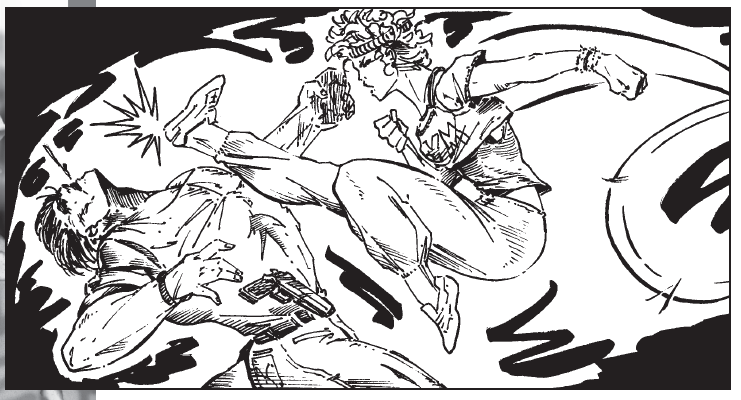
This is not actually Scrapper art. They don't get art. This is just from the chapter.
Fast Healer: Every extra success heals a single wound on a healing roll. I, uh. I don't think this does anything. The healing roll rules read: "Healing is pretty straightforward. At the end of every day in which a hero gets full bed rest, she makes a healing roll. This is a Challenging (10) Strength roll. Each success the hero gets on the roll heals one wound in every wounded hit location at once." So the way the normal healing rule is phrased makes it sound like extra successes heal a single wound across the body. Maybe it heals one more wound in addition to extra across-the-body wounds? I don't fucking know.
Dirty Fighting: If you hit a target in the torso or the head with a fighting attack, add +2d6 to the damage for every extra success. This stacks on top of bonus damage to the head.
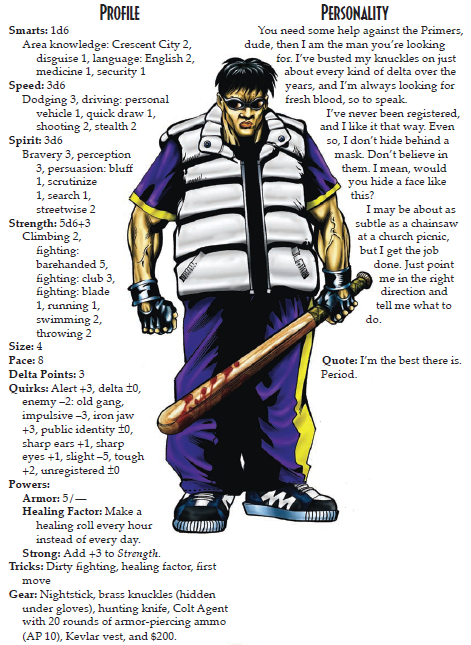
He had a lot of bit parts in action movies in the 1980s as a gangbanger.
Thoughts on the premade character and the Scrapper: Confusing writing for Fast Healer aside, the Scrapper is the counterpart to the Bouncer. They both have augmented strength but the Scrapper can take more of a beating instead of hitting more. At least you're doing more flat damage per attack because you're better suited to melee weapons than fists and they deal more bonus damage. You're still a melee character living in a Dex-focused combat world.
The premade character is competent, so that's good. I, uh. I have a problem with that art because it makes him look like he has no neck and he's generally...unfortunately designed. He looks like a knock-off of Chow from Jackie Chan Adventures. Aside from his very poor choice of character design, I can't criticize much about how he's built besides the fact that I wouldn't have given him Slight because now he takes more damage.
SPEEDSTER
Hello yes it is time for fast. It's recommended that a Speedster have good Strength and Running skill to keep going and going. But they're not The Flash. Good lord as they not The Flash. This is more of a Quicksilver type of fastman.
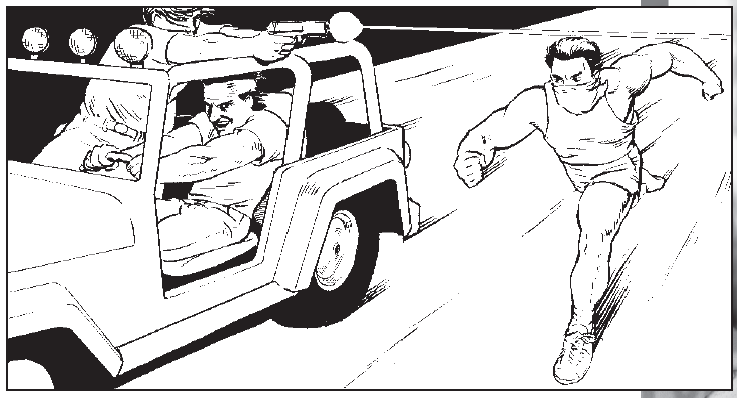
faaaaaaaaaast
For Powers, they get +100 to Pace and +5 to Speed for Dodging and Initiative. Their Tricks are:
Afterimages: For every success over 10 on a Dodge roll, the delta goes fast enough to generate an afterimage that follow them for the rest of the turn. If the delta is attacked, the attacker has to roll to see if they hit the delta or an afterimage.
Burst of Speed: Use an Action to turn extra successes on a TN 5 Running roll into +10 to Pace per success for the next round.
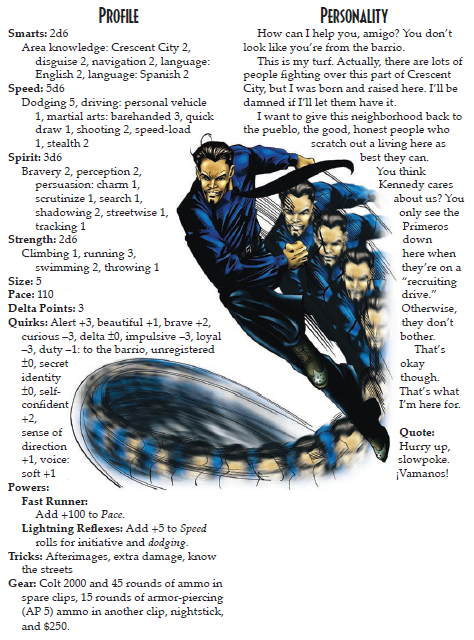
This must've taken a while to draw.
Thoughts on the premade character and the Speedster: Your big advantage is the ability to have multiple actions per round more often. The dodging is very nice, you're the one delta that can charge for 300 feet and deal +10 damage on a melee roll but it's the extra actions that are more important. Personally? I wouldn't even bother with the melee angle. Just dance around the battlefield and abuse positioning to get a low Shooting TN because you get no bonuses to actually attacking. For that matter, run around and drop primed explosives.
As for the premade character. Good job putting points into Dodge and Running. Barehanded martial arts? Not so good but you have a sizable dice pool for that, so. You have a nightstick you don't know how to use but at least you can use that gun. Know The Streets isn't really a handy ability and there's much better choices for you, like say Go First. Also this is the other premade character that I feel is unfortunately designed, especially with the in-character speaking.
FINAL THOUGHTS ON THE CORE DELTAS
I almost want to put them in tiers for effectiveness and usefulness but tiers are stupid and a personal opinion so fuck that. It also would hurt that you're seeing everything colored through my opinion. Unfortunately there's just a clear power disparity in play through the mechanics and design. Instead you get awards! Hooray!
Most Likely To Kill A Room Full Of People Without Breaking A Sweat: Tie between Blaster and Gunner. If I had to pick a winner? The Blaster for not needing to worry about the same weapon logistics as the Gunner.
Best Battlefield Control/Exploitation: Tie between Flyer and Speedster. Honorable mention: the Goliath for knocking everyone around them down with a ground-punch and making the enemy waste movement.
Most Pigeonholed Into One Job: Poor poor Healer.
Melee Class Most Affected By Dex-Focus in Game Engine: Sorry Goliath, but your hindrance for Initiative rolls is what puts you squarely here.
Peak 90s: Dear God, the Gunner.
Most Cribbed Directly From Deadlands: Bargainer.
Best Optional Combat Rule Shenanigans: The Bouncer for being able to pile-drive people or punt them off a roof.
Most Broken Class (Not In A Good Way): Tie between the Gadgeteer for the devs just shrugging and saying "GM fiat" for item creation and the Bargainer missing the majority of its shit to do anything.
CHAPTER NINE: THINGS EVERY HERO NEEDS
This is the equipment chapter! Some of you might be saying "why the fuck are you doing the equipment chapter at the end of this gigantic posts about Deltas?". You raise a good point. The equipment chapter is three pages long. Two of those pages are just tables. It's easy for me to paste tables. Why the fuck is it just three pages long? Because "we don't have time to list prices for everything your hero might want to buy. The solution to this problem is simple. The cost for most items in Brave New World is roughly what it is in the real world". So there you go, if you want to give your delta a corkscrew bong just look up the prices and convert it to 1999 dollars.
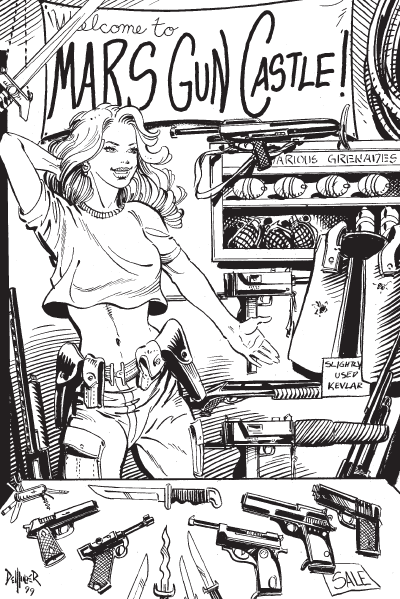
Mars would later go on to start the Brave New World equivalent of Craigslist. In their universe, it's still used a lot for prostitution and casual sex.
In a bizarre turn of events, this game has fucking rules for getting loans. Your hero starts play with basics of modern American life: place to stay, clothes, TV, vehicle, handgun. You start play with $1000. You can get a loan up to your yearly salary on a TN 10 Persuasion roll, with +2 added to the TN for every step above your current wealth level. You can try for a loan every three months where a failure does nothing but a success means you can't get another loan until it's all paid off.
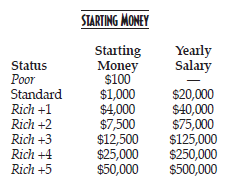
Anyway, boring financial shit aside, here's a fuckload of tables.
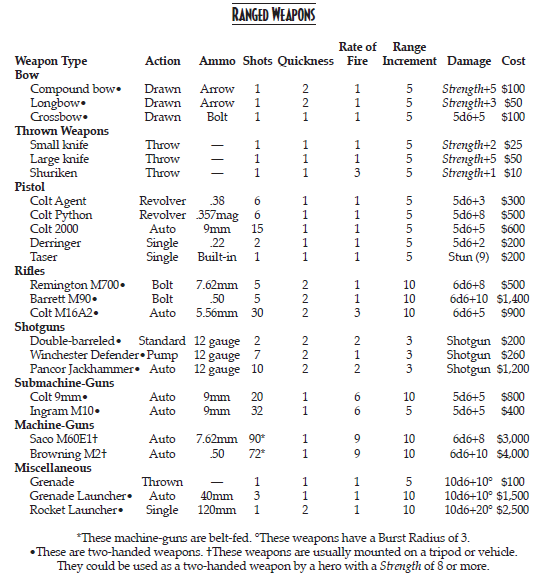
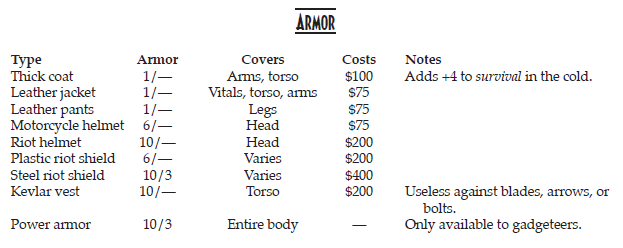
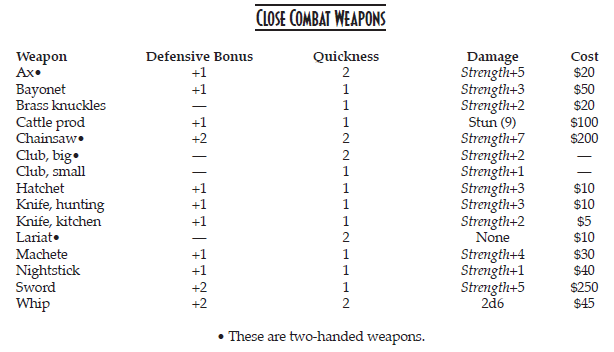

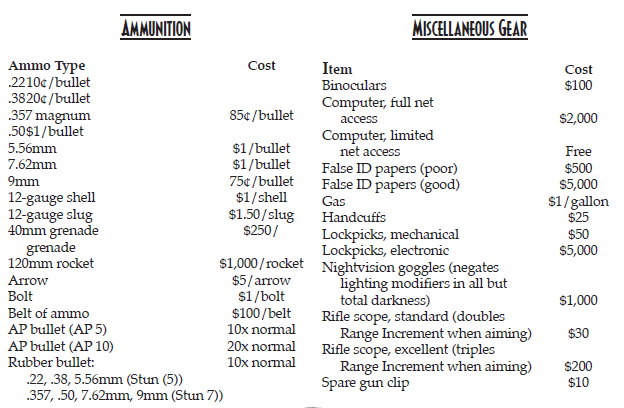
NEXT TIME: Aw hell yeah, GM chapters, settings secrets and premade villains! The next update will be the end of the book, but not the end of the game line.
Post
Original SA post
CHAPTER 10: LIBERTY OR DEATH!
Welcome to the final chapter of the book intended for players to read. As such, this is the chapter meant to justify and explain everything left in a haphazard, clumsy manner.
The big thing is that the average person doesn’t see Delta Prime as a bunch of empowered jackbooted thugs. I will say one interesting thing about this book: it came out in 1999 and the response to The Destroyer’s destruction in Manhattan and the complete eradication of Chicago does manage to encapsulate everything that went wrong with America after 9/11. Now, I’ve been holding back from this comparison for the majority of this review. It’s not a card I want to play; I know two people who died in the collapse of the towers and I don't want to bring up the events lightly. I can’t compare the events in this game to that attack. But I will compare the aftermath of the book’s events to the world I grew up in during the early 2000s. I remember when my parents set up a collection of Emergency Food and stocked water under the stairs to the basement, something they didn’t do pre-Y2K. Choices and decisions were made after 9/11, and they were made after the Bicentennial Battle. So the average person doesn’t see Delta Prime as a threat to their personal well-being. They see Delta Prime as a protecting force, a shield to protect America from all of the bad Deltas who are responsible for the damage done to America. And if you have to give up some things to be safe, so be it. Kennedy didn’t snatch away the Bill of Rights because scared people handed it to them.
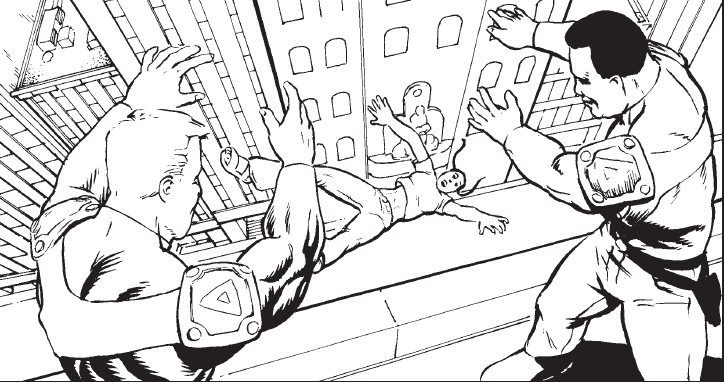
So now the government does stuff like this, I guess.
But there’s also a strong undercurrent of governmental abuse through this whole thing. Normal people are disappeared in regular government prisons or press-ganged into military service. Most people keep their heads down. If you’re a Delta, you know how bad it can get. You either register and become a government item or don’t and spend the rest of your life looking over your shoulder. In-game, if you are an unregistered Delta and you’re captured by Delta Prime, that’s it. No plot recommendation to later have a jailbreak, that’s it; make a new character. The game also recommends that despite either being a one-note delta or incredibly lethal, you should fight for life, liberty and the pursuit of happiness and try to set an example as a responsible Delta. If anyone else has played City of Heroes: Going Rogue, you should play the more responsible side of the Praetorian Resistance instead of the side that just murders Loyalists.
Man this game has a lot in common with City of Heroes.
Let’s talk about Delta Points and Experience. Every PC starts play with at least 3 Delta Points which have two uses. First, completely negate a single wound. Second, roll another dice to add it to a roll that comes up short like the low result exploded. You don’t keep your pool of Delta Points from game to game. They refresh at the beginning of each session.
Experience Points are exactly what you think you are. They’re used for four things: Raising Traits, Buying/Improving Skills, Buying Off Negative Quirks, Buying New Tricks. Raising a Trait got costs 3xNew Score points, buying/improving skills costs New Score points, the price of buying off a Negative Quirk is the price of the quirk and all new Tricks cost 10 points. Do you want new Positive Quirks or to improve your current powers? Tough shit! You can never improve those! Hope you don’t regret not buying certain quirks!
How the hell do you earn those points? Play the game and play it well and don’t be a murder hobo, be a good upstanding freedom fighter. Also have fun or something, that’s something you do right?
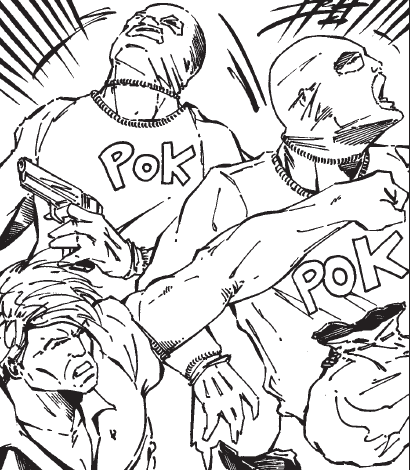
The illustrious sound 'pok', up there with 'wungo', 'fleem!' and 'kflang'.
Chapter Ten Thoughts: I could give less of a fuck for the reasons to actually want to be in Defiance. This is up to how your GM sells the game and how you and the rest of the players talk about what you want to do. I care more about the actual mechanics. Not being able to improve your one-note powers is absolute horseshit. Not being able to improve your quirks is less horseshit but still pretty horseshit. I know that at the end of the day improving your powers incrementally isn’t thematically good for this game. I understand that it was building towards the return of Alpha powers or whatever (it was building towards something bigger than that, but). It’s still unforgivable for 1/5th of your classes to be unplayable/broken with zero chance for reform or advancement beyond skills and tricks. Let’s be honest too: the only thing raising traits does is raising your dice pool, tricks are at best okay, TNs for skills aren’t particularly high and negative traits are annoying. And your players are going to either get bored fast with their slow advancement or they’re going to get devious as fuck with what they can do from the word go, like abusing flight to just drop explosives on people. I mean it’s just on the fucking nose of me to say that this system is bad after all of these concrete examples. But every time I think the game is done slapping shitty condiments onto a bad sandwich, the guy at the deli lifts the top bun and finds something new.
CHAPTER ELEVEN: GUIDING THE GAME
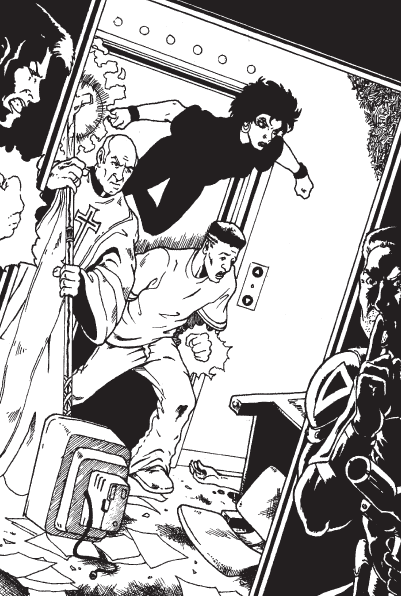
"So a priest, Dr. Frank-N-Furter and Kid of Kid 'n Play walk into a bad guy's hideout..."
Players fuck off it’s ~GM TIME~ HELL YEAH!
The first two pages of the GM session are: what is GMing, how to GM, you have the touch and/or the power and you have access to a world and info the players don’t, try to play with three or four players. Then the game asks you an important question: how do you play a game set in Brave New World?
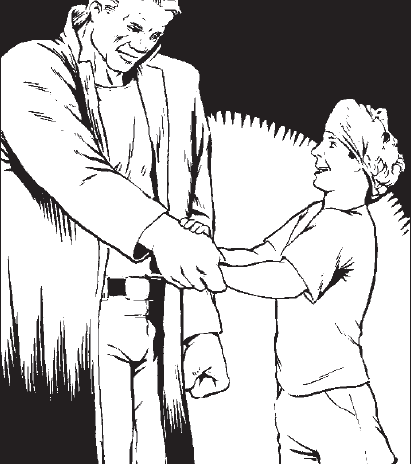
Marv from Sin City is a friend to all children and a role-model for them to look up to.
The answer is: well, do you have the GM screen for BNW? There’s an official adventure in that. Do you not have that screen because it’s the year 2016 and the PDFs created in 2009 never included the GM screen/guide? Well fuck, have the other advice then. A saga is a series of stories told over multiple sessions. Come up with a back-story for the whole adventure you have planned and figure out how it would go if the players never intervened or came in at a time different than you intended. Come up with two or three different directions the story could go and split the story into chapters. Pre-make your characters using Profiles that you can alter when you need to have a certain character be the same but different than other enemies. Create major and minor extras, with the explicit advice of “major extras are recurring villains, minor extras are generic goons and feel free to ignore the finer details of how they’re real people interacting with your characters and possibly getting murdered”. Do group initiative rolls for minor extras and single roles for important extras. Have attacks deal full-body wounds to extras to make things go faster and let them live if the players are squeamish about killing or kill them to make the cops hate the players. Have the players come up with a list of reasons for why they’d be interested in the plot at hand and then “figure out what the heroes’ buttons are and then push them. Hard.” Use maps. Use the minis. Why the fuck wouldn’t you. Buy stuff from Pinnacle. Make sure the players are having fun or they’ll quit.
Probably the worst thing from the GM chapter: give out 1-2 experience points a chapter to heroes who deserve it. If they’ve done more than that or it’s an important chapter, 3-4 points and no more. Or give them friends, enemies, money, equipment or a Delta Point that can only be used this/next session.
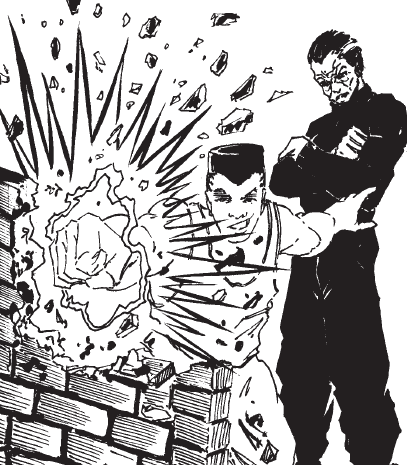
Chapter 11 Thoughts: Where the fuck do I begin.
Some of this is inoffensive info, like “don’t worry about the hit points for goons too much” or “plan for if the characters decide to get a latte and miss the bank heist”. But the way the answer to “how do you play a game in this setting” should not be an attempt to answer without answering. It is a bullshit technically correct response. There are zero plot hooks in this section and that’s what’s important. How to play, sure, but what could you play? Shrug, think of something. Second god those are peanuts for stringing the players along with the promise of points. After three sessions, you’ll generally have enough for a skill boost/new skill or to buy off a negative quirk. Want a new Trick? Wait ten sessions. Want a Trait boost? Wait as long or equally long. Fuck that. Goddamn peanuts. Also "pushing buttons to get the players to play the game" is a sneeze away from "railroading". You should think of what you know about the player's Delta to figure out why they would be interested and let it arise organically.
CHAPTER TWELVE: WHAT’S REALLY HAPPENING?
Because they couldn’t name this chapter “What’s Going On?” without chipping a dollar or two to the estate and rights of Marvin Gaye’s work.
So. Secrets of the setting. Let’s break it down into segments.
What’s Up With Defiance?: The lady who runs the Delta Times online newspaper is a reporter for the Crescent City Star, a newspaper for Crescent City. She’s a Delta and her power is the ability to sense the truth, hence her codename of The Truth. Specifically, she can hear a statement and know if it’s true or not, but that’s it. Her editor refuses to print some stories because the government has come down on them a few times for stories, so some of them get put on the Delta Times. As a result it’s an accurate newspaper that is at least speaking SOME truth.
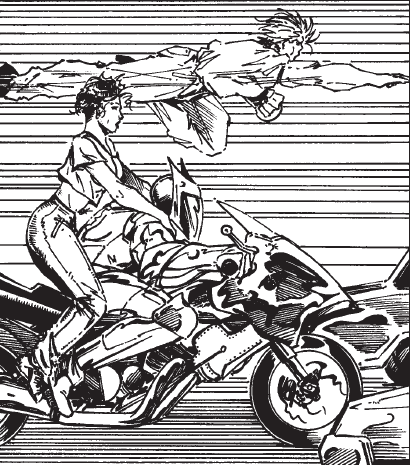
nyyyyyyyyyyyyyrrrr
Okay but what exactly is Defiance. To the American public, Defiance is a collection of terrorists and people who just don’t want to register. In actuality, you can call yourself a Defiant for not registering, but there actually are cells of Deltas protecting each other from the law or actually planning on fighting the government. You only get into the actual structure of Defiance by going to the website, saying you want to help and then eventually you get a chance to prove yourself. If you do well, you’ll get more assignments and eventually get brought into the fold proper. If you suck at it, you probably never get to see anything behind the main news page. This also is what happens if you get burned, that or they’ll feed you lies and crap.
Where Do Delta Powers Come From?: Up until the Human Genome Project, nobody had a clue. But the scientists ended up finding a similar sequence that some people don’t have but most Deltas do in some sense. This is called the Delta Factor (because why not) and it appears in some form, mutated or altered but that DNA code is there in all Deltas.
The big question is “where the hell did it come from if it’s not there in normal humans? Is it a pure mutation? Is it from some other source?”. This has quickly become a big thing in conspiracy circles who have dedicated themselves to figuring out where the Delta Factor came from and why it kicks in when people are near death. Some blame Nazis or Soviet super science (despite Silver Ghost getting their powers in World War 1). Some people blame aliens or government experiments. And then there’s the Delta Cult, a cult of wonks who believe that Deltas are demigod children of old gods and entities and that they will return to get their offspring when the time is right/stars are right/nothing is good on TV.
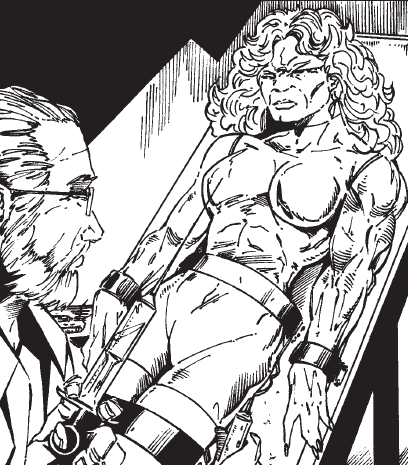
There is quite a lot wrong with this picture and I would like to see what this looks like in color done by the original team to see if it would be worse. I dunno if she's supposed to be a Goliath or what.
Where Did the Alphas Go?: Hold on, let me tell you another story first.
Why Is Kennedy Such A Dick?: Because he’s not JFK. JFK was straight-up killed alongside his wife and the governor of Texas in the Dallas attack. Superior did in fact swoop in and save the day and try to fly the president to a hospital in Dallas, but JFK died en-route.
So Superior had an idea, the kind of idea a morally-questionable superman would have. He brought JFK’s body to the house of an Alpha he knew in Washington DC. This man was Façade, an Alpha with the power of shape shifting and mimicry. He flew Façade in the form of JFK to Walter Reed hospital, said his Alpha healer friend Doctor Abrahams healed him but he’d need a few days to recover, then flew to Abrahams and basically said “hey we’re bros and I used you in a lie are you okay with this”. Surprisingly Abrahams said yes, probably because he didn't want to be torn in half.
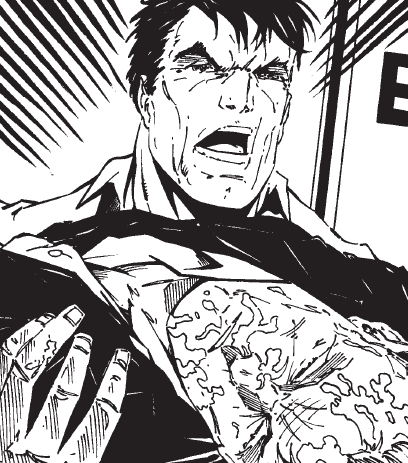
Superior and JFK.
Thanks to Jackie being dead and the cranial damage the real president suffered, Façade woke up and blamed memory loss and lapses in personality on a head wound. Façade pretended to be JFK, Superior was the real power behind the presidency and anyone who got close to the truth was either brought in on the line or quietly killed. Superior was responsible for the Delta Registration Act, cementing him as a complete dick because that was the first step to martial law and the American junta. Somehow Superior had seen the movie Dave like thirty years before it came out because the plan was for JFK to quietly die and a new puppet to be brought in for Superior to control.
So Where Did the Alphas Go?: Façade didn’t want to share the presidency and was tired of Superior bossing him around. So JFacadeK told a Primer Gadgeteer to build a device that would get rid of Alphas and basically anyone who could threaten him. That Gadgeteer pretended to be a freelance nut, sold it to the head of Evil Unlimited who sold it to the Devastator who used it to threaten Chicago. The entire thing was the equivalent of a stage magician’s misdirection, bringing the city of Chicago to wherever it brought the unshielded Alphas. So the Devastator ultimately didn’t kill the entire city of Chicago but he was somewhat responsible for protecting Façade’s presidency. The secondary effect was that it suppressed people from becoming Alphas somehow. Anyone left who is still an Alpha is either imprisoned or someone Façade doesn’t consider a threat. Also maybe sometimes people still become Alphas I dunno whatever.
Tell none of this to your players and in the future I’ll still be calling JFK JFK because I don’t want to keep calling him Façade.
CHAPTER THIRTEEN: THE USUAL SUSPECTS
ENEMIES ENEMIES ENEMIES ENEMIES oh boy enemies. Are you excited? No? Eh, alright. This is the closest thing to Plot Ideas you will find in this book. And that’s kind of sad. Note: these enemies are not in alphabetical order because they’re not in order in the book and I want you to experience how this whole chapter is laid out. I will also not be talking about their general stats or abilities, just their presentations and their usefulness to the game as a whole.
AQUARIANS
Fish people from an underwater society!
No wait, come back! Come back here and look at the scope creep.
Aquarians are Deltas whose power was “be a fish person with normal skin tones”. A lot of Aquarians live in Chicago Bay where the Sears Tower used to be, their “village” called New Atlantis. They’re reclusive and somewhat secretive. They have issues with Delta Prime and Chicago and are generally blamed for problems and called terrorists for being Deltas. My main criticism of their plan is that if there’s one thing I’ve learned from Bioshock it’s that running away to live at the bottom of the sea doesn’t protect you from the world’s problems.
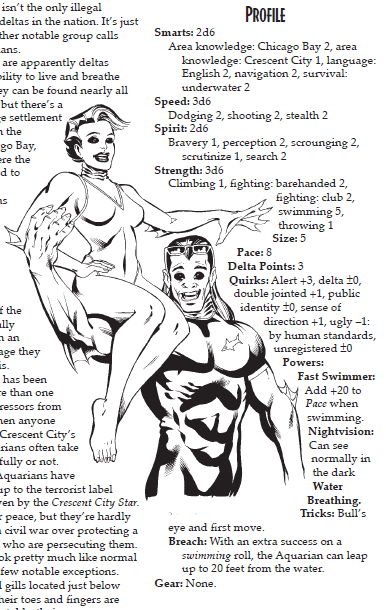
Thoughts on the Aquarians: Okay so why do they have to be a thing? I get the idea that there should be more inhuman deltas, and that’s actually not that bad of an idea. But we don’t know anything about Crescent City at this point and from what limited info we have of the world, Fish People are not something I expected, especially as the first NPC. You’re not even offering much to do with them by saying “look some are good, some are evil, what do you want from me? They’re still people despite being amphibious”. Also I have to generally take major umbrage with the notion that Aquarians (hell, Goliaths) would be ugly or ugly by human standards. I’ve seen that gif of a dragon fucking a car. There would be a lot of people who would want to fetishize the shit out of them for being different at the very least.
EVIL UNLIMITED
Evil Unlimited is the prime supplier of items and goods for evil/supervillain Deltas. The organization has regular people and Deltas and the business is a black market of associated groups. They are mysterious and they contact people through their Sales Reps.
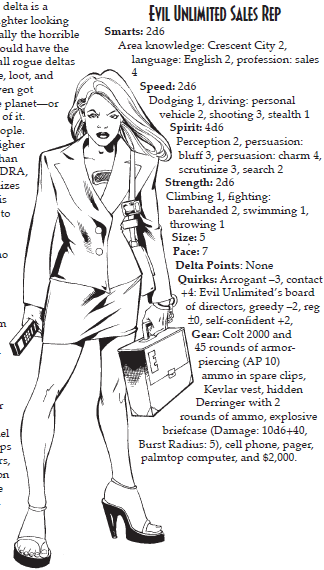
Thoughts on Evil Unlimited: That’s all they have to offer us, the mildly armed evil sales rep. This is barely anything. I get that there’s ten pages left, and I get that Evil Unlimited will get a later book, but is this really all you need to offer? It’s just maddeningly sparse, you’re leaving this completely up to the GM to figure out at this point. It’s insulting!
DEADERS
Deaders are corpses re-animated by having a chip placed in their brain and stimulated by a Gadgeteer's gadget control panel to give them the illusion of life. The technology is well-known amongst grey/black hat Gadgeteers who are willing to tamper with dead bodies in the pursuits of "science". As long as the machine transmits the life-giving impulses, the Deader has to comply with their master's commands. Apparently all it takes is makeup and cologne to make a walking corpse pass for human because they rarely speak.
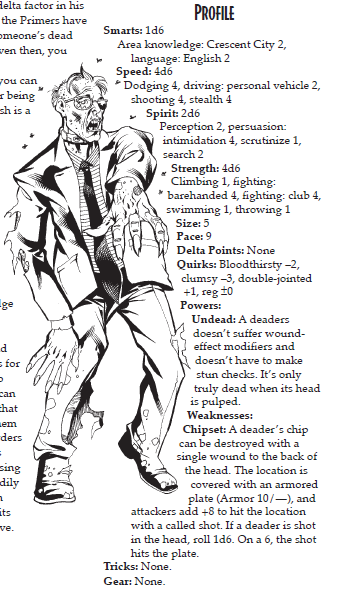
Thoughts on Deaders: This is a bad addition. It clashes tonally with the rest of the book, and I know how stupid it sounds considering that this is a superhero book. I know that this is a semi-realistic setting with the major exception of Bargainers getting demon totems but there's absolutely no indication of anything along these lines happening. The thing is, Bargainers get mentioned to the reader early enough in the book that it seems weird and tonally incorrect but hey, you gave me forewarning to ask 'why?'. When your main selling point for Gadgeteers is Power Armor and being able to mimic the powers of deltas somehow maybe, throwing in being able to reanimate the dead with shock chips and a control panel is out of fucking left field. I would prefer the god damn Aquarians more than this, Jesus Christ.
DELTA PRIME
Okay we've spent enough time for you to get a grip on Delta Prime, the paramilitary Delta thugs who help JFK rule America with an iron fist. The main focal point of the Delta Prime entry is the Armorgeddon Pilot. The Armorgeddon Suit is a suit of power armor developed by Delta Prime's Gadgeteers. It's a big part of their arsenal, which is why the creating Gadgeteer is not the pilot. An Armorgeddon Pilot is a trained soldier who has a Gadgeteer assigned to them for maintenance. The two of them bond or something I'd imagine, but if the pilot dies the suit can be rebuilt and given to a new pilot.
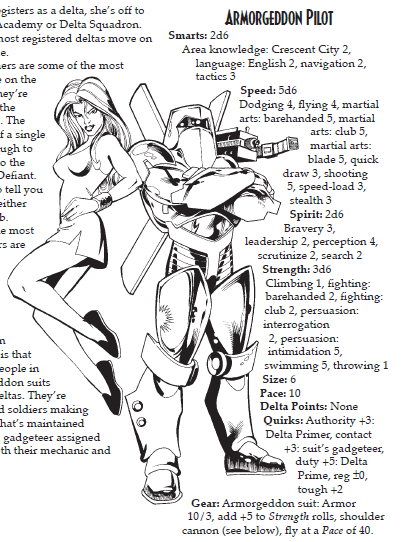

Thoughts on Delta Prime: I really would prefer a basic Delta Prime hero like a Scrapper or Bouncer or Gunner. The Armorgeddon Pilot is a gigantic jump in power and tonal danger compared to the other sample villains. That guy's shoulder gun is as powerful as a Blaster's blasts and he can eat damage compared to the others thanks to his armor. Actually I'll break my rule real quick about not talking about the mechanics. All he has is the suit with that gun. He's got impressive fighting ability but no clubs to use and no blades. Also, it does nothing to protect against a Blaster's blasts because that's wearable armor. So, very much dangerous to the majority of heroes he'll run into except for his Achilles Heel.
POLICE
Cops know they're no match for a Delta but they have numbers. But also cops are people too. I dunno. You know the police, you know they'll hound you and you don't want to piss them off too with your activities.
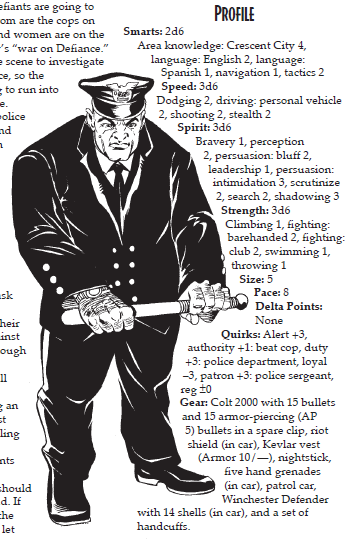
Thoughts on Police: I actually appreciate that they're loaded for bear. I don't have much to say about this inclusion. It makes sense and it's a handy ability reference to have on hand. Good on that.
MAFIA
The Italian mob is in the pockets of the United States government. That's a weird thing to say, but there it is. Early on, JFK took initiative and brought the Mafia under governmental control and now most of America is a lot like Chicago. The mob runs unions, drug smuggling/sales, prostitution, vice and sin and some of the money goes back to the government while the bosses make bank legally. Plus, criminals can pass tips back to the government for kickbacks. It's described as being surprisingly efficient if you're on the good side of the mafia. The connection isn't public, though, and if the truth was to come out it would be an absolute shit show for JFK's image and American credibility.
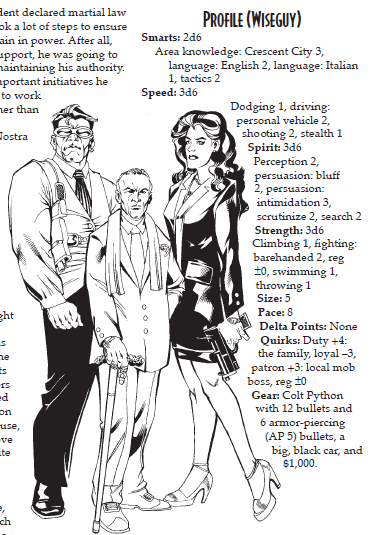
Thoughts on the Mafia: On the one hand I'm kind of torn about this idea. If I was a player, I might feel it was a cop-out to find out that Giovanni Stereotype was actually connected to the hideously corrupt government. It would feel like a no-shit moment. On the other hand, it's a nice bit of world building and if it's played right I don't think it would hurt much. It could provide a nice way to transition from small crime to the threat of the government. Like all ideas in this game, it requires the right touch.
VAMPIRES
Here just have the picture and the stats for vampires. Read it for yourself.
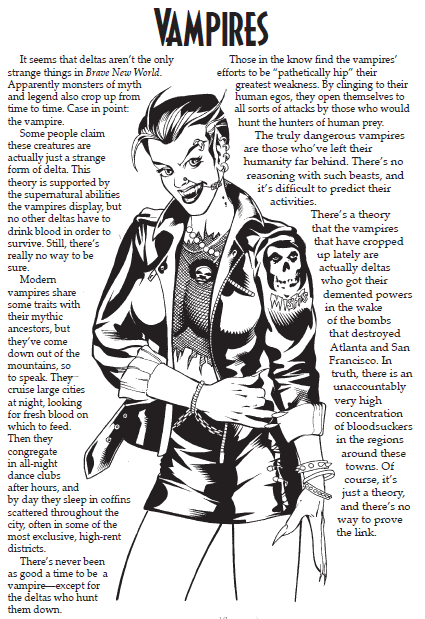
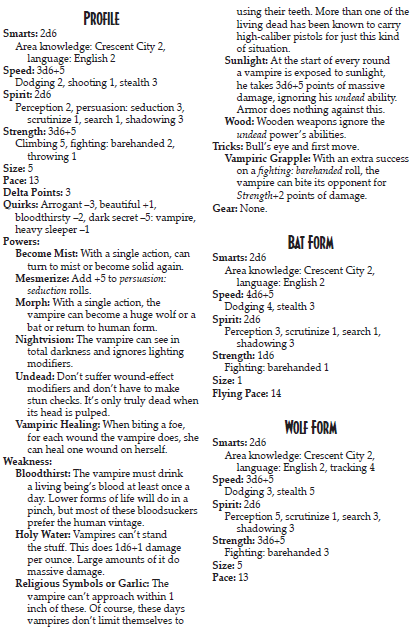
Thoughts on the Vampires: FUCK.
Let me try that again.
Vampires have a stupid amount of things going for them. Shapechanging, blood-drinking, all these strengths and weaknesses. It's just so fucking off kilter thematically too. Are they unstoppable? Absolutely not, they're actually pretty shit at everything they can bring to the table. They should really have more in their Barehanded Fighting if that's how they get anything done. But I want you to just look at the fact that there's a possibly radioactive, possibly superhuman shape shifting blood-drinking vampire on this list. Where even in the fuck did this come from? There's an answer that will come much later down the line and it's wholly unsatisfactory. The only thing I can say in favor of this is that I really do enjoy this art quite a bit. It's nice art.
So yeah. Fuck.
FINAL THOUGHTS ON THE BRAVE NEW WORLD CORE BOOK
You might think that this book makes me angry. That's not wholly true. I am more incredulous than anything else. I was right when I said that my sympathy might wear off. I do still sympathize with Matt Forbeck, I honestly do. But this setting, I feel, would have been better as just a book he wrote or as a homebrew setting he put together with some of his friends. This book was absolutely nothing what I expected and I am still somewhat amazed that this exists. But you know, I'm sort of glad it does. I don't feel like I've truly reviewed a bad game until Brave New World. Unhallowed Metropolis/Necropolis were bad, sure, but that's because they were boring from a mechanical standpoint and just too grim and dour to function.
Brave New World is a bad game. But it's certainly piquing my interest and getting me to look deeper into it, and I can't say I'm not entertained writing this up for you guys. If this was boring and a chore, then this would be my last entry for the entire shebang.
But it's not. And you better believe that I'm covering the goddamn sourcebooks.
There are eight more books for the entire run of Brave New World. The GM's screen is unavailable to me because that was a tangible thing and they could never port it to PDF. And I've been skimming the other books and let me tell you something: they do not make the game any more balanced or fix anything.
Last year in the summer, I found a PDF depository of nWoD game lines and extra books for plot hooks. Over the course of July, I devoured Promethean, its side books and a lot of the other plot idea books like Ghost Stories, Midnight Roads and Asylum. Let me tell you a secret: when you shotgun nWoD books back to back to back, you quickly realize how formulaic they are. Ridiculously formulaic. This is no surprise for some of you guys out there who have way more experience than I have, but the nWoD book formula is there to keep the books easy to structure and get out in the world. And sometimes, this is to their detriment.
They are not nearly as shameless as Brave New World's books, where literally all of the books I've looked at are 120-160 pages long apiece and divided into two sections. The first half, give or take 5-10% more, is strictly in-character fluff and world building for the players to read. The entire second half of the book is, in short succession, new powers, new premade characters, new truths about the setting for the GMs to know and maybe a new adventure if you're lucky. There's going to be new powers, new art and re-used art and the metaplot backstory is going to quickly gain the structural sense of the Winchester Mystery House. So join me NEXT TIME when we crack into the rest of planet Earth through BRAVE NEW WORLD: RAVAGED PLANET!
